Handling and Storage of Audio and Video Carriers
printed edition | web edition
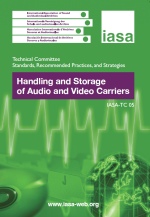
This is the  English language web edition of IASA-TC 05, Handling and Storage of Audio and Video Carriers. It is also available in other languages - please see IASA Special and Technical Publications
English language web edition of IASA-TC 05, Handling and Storage of Audio and Video Carriers. It is also available in other languages - please see IASA Special and Technical Publications
Recommended citation style:
IASA Technical Committee, Handling and Storage of Audio and Video Carriers, edited by Dietrich Schüller and Albrecht Häfner. First edition 2014. (= Standards, Recommended Practices and Strategies, IASA-TC 05). www.iasa-web.org/tc05/handling-storage-audio-video-carriers
Table of contents:
Publication Information
IASA Technical Committee
Technical Committee Standards, Recommended Practices, and Strategies
Handling and Storage of Audio and Video Carriers
IASA-TC 05
Edited by Dietrich Schüller and Albrecht Häfner
Contributing authors
George Boston, Kevin Bradley, Mike Casey, Stefano S. Cavaglieri, Jean-Marc Fontaine, Lars Gaustad, Albrecht Häfner, Stig-Lennard Molneryd, Richard Ranft, Dietrich Schüller, and Nadja Wallaszkovits
Guest authors
Friedrich Engel, Patrick Feaster, and Sebastian Gabler
Reviewed by the IASA Technical Committee (TC)
Published by the International Association of Sound and Audiovisual Archives
Handling and Storage of Audio and Video Carriers (IASA-TC 05)
Edited by Dietrich Schüller and Albrecht Häfner
1st Edition 2014
This publication provides guidance to audiovisual archivists on a professional approach to the handling and storage of physical audio and video objects
Copyright: International Association of Sound and Audiovisual Archives (IASA) 2014
Translation is not permitted without the consent of the IASA Executive Board and may only be undertaken in accordance with the Guidelines & Policy Statement, Translation of Publications Guidelines, Guidelines for the Translation of IASA Publications & Workflow for Translations (http://www.iasa-web.org/translation-publications-guidelines)
1 Introduction
1.1 From carrier conservation to content preservation
A substantial change of paradigm in audiovisual preservation began as early as 25 years ago. Until then, audio and video preservation followed the traditional pattern that is still valid for archives of text documents and museums around the world: To safeguard the objects placed in their care.
Around 1990, however, audio archivists began to realise that following this principle would ultimately be in vain. It was becoming obvious — and this is the topic of this publication — that audio and video carriers are vulnerable. Most are unstable when compared with the great majority of text documents. Moreover, being machine-readable documents, the availability of replay equipment was equally important for the retrieval of their contents as carrier integrity.
By that time, it was also becoming obvious that the digital technologies and the enormous pace of technical innovation was creating new formats in an ever faster sequence and, therefore, with ever shorter life cycles. This would confront archivists with the additional challenge of keeping the format specific replay equipment for an ever-growing number of formats in operable condition.
This led to the change of paradigm: Safeguard the content, not the original carrier, was the new mantra. This is achieved by copying the contents from one preservation platform to the next. In order to avoid copying losses, copying has to be done in the digital domain. Analogue contents have, therefore, to be digitised and, together with pre-IT digital contents, converted into files. These will be safeguarded like all other computer files by adequately equipped and managed digital repositories.
While in its beginnings this new paradigm was not accepted without dispute, it was widely adopted for audio archiving from the early 1990s onward and was accepted soon after by video archivists. Meanwhile, because of the global change from analogue to digital film projection and the retreat of the industry from the production of analogue film, this principle is now also widely applied in film preservation.
1.2 IASA’s role
IASA members have been active players in this process, and IASA as an organisation has always provided an open platform for this development. As a consequence, this principle has been codified as a standard by the IASA Technical Committee in The Safeguarding of the Audio Heritage: Ethics, Principles and Preservation Strategy, colloquially referred to as IASA-TC 03. This is now in its third version and available in eight languages. The message, in a nutshell, is:
Long-term preservation of audio (and implicitly also for video) can only be achieved by converting contents into files, and by maintaining these files like any other computer data.
Consequently, after codification of the principle, in 2004 IASA published IASA-TC 04, Production and Preservation of Digital Audio Objects, and is preparing IASA-TC 06, Production and Preservation of Digital Video Objects.
More information about these publications can be found on the IASA website at http://www.iasa-web.org/iasa-publications.
1.3 The rationale for this publication
Why does IASA now publish this document at the end of the era of traditional audiovisual carriers?
It is true that a considerable part of the worldwide audio and video holdings1—typically those owned by broadcasting and national archives of wealthy countries—have already been digitised, or are on their way to being digitised for long-term preservation. Although the new methodology of audiovisual long-term preservation had been universally accepted by the end of the 20th century, there remains a considerable part of the audiovisual legacy that is still stored on its original carriers. The main reason is obviously the lack of funds. But also lacking is a sense of urgency to complete the digitisation of content.
There is an ever-decreasing time window to complete the digitisation process before the small pool of equipment in operable condition required for the replay of traditional formats vanishes. Today, this window is estimated to be between 10 to 15 years2, which makes the provision of optimal storage conditions imperative. This is particularly important for archives in hot and humid climatic zones. The purpose of this publication is to assist stakeholders to optimise storage conditions as an interim measure before professional longterm preservation through digitisation can be funded and organised.
Additionally, optimisation of life expectancy assists the archive to follow the recommendations of IASA-TC 03 to keep the originals in good storage after digitisation as a safeguard against technical advances making better copies possible.
Under no circumstances, however, must these guidelines be misunderstood as being a complete solution. It is dangerous to assume that conventional conservation (passive preservation) may be a viable method for achieving the long-term preservation of, for example, a mixed media collection. Inevitably, deterioration will progress and will ultimately limit the retrievability of stored signals. An even greater threat is the increasing difficulty of obtaining working replay equipment and spare parts to keep machines operating. For several tapebased formats, the shortage of replay equipment is already very severe. Sooner or later, even the most carefully preserved carriers will become totally unplayable. Active preservation by following IASA-TC 03 and TC 04 is absolutely imperative.
1. The world-wide archival holdings of audio and video carriers have been roughly estimated to amount to 200 million hours. This estimate, however, includes multiple copies.
2. On average, for magnetic tape based documents this time window may be even shorter, for mechanical and optical carriers probably longer.
1.4 Content, organisation, bibliography and citations
TC 05 concentrates on measures to optimise conditions for the preservation of physical and chemical integrity of traditional, haptic audio and video carriers. It concentrates on those carriers of recording systems that have been accepted by the market, and form 99% (or more) of all audio and video collections. It is not a handbook of audiovisual recording systems. Therefore, it does not discuss the vast variety of instantaneous audio discs, or rarely used recordings systems like magnetic wire or steel tape, Philips-Miller, Selenophone, etc., and mechanical video discs such as TED. The mainstream recording systems, however, are explained to some degree, in order to provide a basic understanding of the specific function and features of carriers: why and how handling and storage could negatively or positively influence their physical and chemical integrity, and what influence damage and/or deterioration processes would have on signal retrieval.
TC 05 is not a catalogue of mere Dos and Don’ts. Optimal preservation measures are always a compromise between many, often conflicting parameters, superimposed by the individual situation of a collection in terms of climatic conditions, the available premises, personnel, and the financial situation. No meaningful advice can be given for all possible situations. TC 05 explains the principal problems and provides a basis for the archivist to take a responsible decision in accordance with a specific situation. This is the reason why, for example, climatic storage ranges are recommended rather than strict figures, which often trigger a false feeling of security, whereas each chosen value is only a compromise. This is also the reason why TC 05 does not provide a general “Code of Practice”, as this would hardly fit the diversity of structures, contents, tasks, environmental and financial circumstances of collections. However, archives are strongly encouraged to develop and codify, within the limits of physical and chemical constraints, their specific rules of procedures.3
This set of guidelines is broadly divided into two main parts. The first part (Section 2), explains the main types of audio and video carriers, their composition and recording principles, physical and chemical stability, and deterioration caused by normal replay.
The second part (Sections 3–5), advises on best practice for passive preservation through careful handling and appropriate storage and transport conditions.
It should, finally, be noted that cleaning and restoration of carriers is not part of this publication. These aspects are part of signal extraction and discussed in IASA-TC 04, chapter 5. The bibliography lists books and articles, including electronic information, which have become the “mainstream” of audiovisual preservation literature. Generally, the information and recommendations of this publication that are based on common and undisputed knowledge are not specifically referenced. However, references are given when — because of new experiences or information, or research — new recommendations are made or deviations from the mainstream of earlier recommendations are suggested. In addition, it should be noted that this book also contains primary source information: observations and appraisals based on the experiences of the authors gathered over years and decades.
As these guidelines concentrate on handling and storage, there is generally no discussion of variants and discrepancies between publications concerning composition and/ or deterioration of materials.
Cross-references to IASA-TC 04 are made to the second edition (2009) of these guidelines.
3. The British Library National Sound Archive Code of Principles may serve as a structural example. In A.Ward 1990, Appendix 1.
1.5 Responsibility
This is a publication within the series of the IASA Technical Committee: Standards, Recommended Practices and Strategies.
Contributing authors are the following TC members:
George Boston
Kevin Bradley
Mike Casey
Stefano Cavaglieri
ean Marc Fontaine
Lars Gaustad
Albrecht Häfner
Stig-Lennard Molneryd
Richard Ranft
Dietrich Schüller
Nadja Wallaszkovits
and the guest authors
Friedrich Engel
Patrick Feaster
Sebastian Gabler
Unless otherwise quoted: Technical drawings are by Albrecht Häfner, photographs by Dietrich Schüller and Nadja Wallaszkovits.
The publication was reviewed by the IASA Technical Committee.
This text has been composed and checked with great diligence. It represents today’s knowledge and the present foresight of risks. However, the great variety of materials, and of concrete environmental and handling factors may require individual solutions, for which this text is aimed as a general guideline. Many aspects determining the physical and chemical stability of carriers and their components are yet not fully understood. Therefore, neither the editors, the authors, the Technical Committee, nor IASA as an association may be held responsible for any damage or loss which might be ascribed to the recommendations or opinions expressed in text.
The editors would be indebted for comments on possible omissions, mistakes, or new development or experiences that may shed new light onto the recommendations given.
English language editing was in the hands of George Boston. As many readers of this document will be non-native English speakers, simplicity of expression was the aim. Like the other IASA-TC publications, orthography follows UK rules.
Cooperative publications involving experts actively engaged in their daily professional lives are a challenging task. Consequently, the completion of these guidelines took longer than originally expected. The editors would like to express their gratitude to the contributors for their input, the Technical Committee for its review and support, IASA Editors Bertram Lyons and Richard Ranft for their assistance and substantial efforts in converting the manuscript into print and web editions, and, eventually, the IASA Board, IASA members and other readers for their patience in waiting for its completion.
Dietrich Schüller
Albrecht Häfner
September 2014
2 Type of Carriers , Recording Principles, Composition, Physical and Chemical Stability, Deterioration by Replay
2.1 Mechanical carriers
2.1.1 Recording principle
Mechanical carriers constitute the oldest, commonly used type of carrier used for recording and reproducing audio. The first true recording system was the cylinder phonograph, invented by Thomas A. Edison in 18774, improved and marketed from 1888 onwards. Originally intended as an office device for dictation purposes, it became popular for scholarly recording of language and ethnic music from the 1890s until the 1950s. Cylinders were also used by the phonographic industries for pre-recorded music. This format, however, was less successful as a commercial product than the gramophone disc and, though it was still used for recording, replicated carriers vanished from the market in the late 1920s. Mechanical disc formats governed the pre-recorded music market from the early 20th century until the 1980s, when they were superseded by the Compact Disc.
In recording a mechanical carrier, the sound, which is a function of the variation of air pressure, is transformed into movements of a cutting stylus and engraved into the surface of a rotating medium. This was originally done by purely mechanical methods: the sound was captured by a horn and moved a membrane at the closed end of the horn. The membrane was connected directly or by levers to a cutting stylus, which engraved the movement of the membrane into the surface of a rotating wax cylinder or disc. The reproduction of the sound reverses the process: a stylus is moved by the modulated groove and drives a membrane, the vibrations of which are amplified by the horn.
By the mid-1920s this acousto-mechanical process was superseded by a magneto-electrical system in which the sound is transformed by a microphone into an electrical signal that moves an electrically driven cutting stylus. The reproduction was also improved by electrical pick-up systems, the amplified signals of which are converted to mechanical movement by a membrane in a loudspeaker or headphones. Recently optical, contact-less replay of mechanical carriers has been developed which, however, for various reasons, has not achieved wider acceptance. (For signal retrieval from mechanical carriers see IASA-TC 04, sections 5.2 and 5.3.)
4. This first “tinfoil phonograph” of 1877–78, which recorded by indenting a tinfoil sheet wrapped temporarily around a cylinder, is typically distinguished from the later “cylinder phonograph” which recorded by cutting a groove in a permanently cylindrical carrier.
2.1.1.1 Cylinders
With cylinders, the groove is cut in a helix across the surface. The modulation of the sound signal is engraved vertically (“hill and dale”).
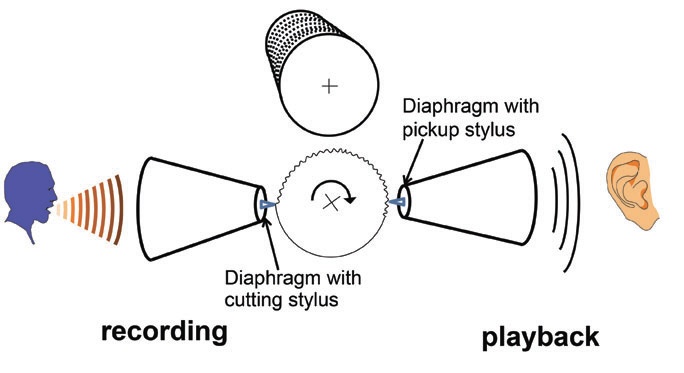
Figure 1: The recording and reproduction principle of cylinders.
There are instantaneous and replicated cylinders. Cylinder replication was possible either by a copying process from masters, which allowed a limited number of slave cylinders to be made. Another process was replication from a galvanoplastic negative, a copper tube, which carried the “inverted” groove on the surface of its inner side. These negatives were used to make wax casts or to create celluloid (=cellulose nitrate) positive tubes produced under high pressure steam. The celluloid tube was then stabilized by inserting a core made of plaster or other materials.
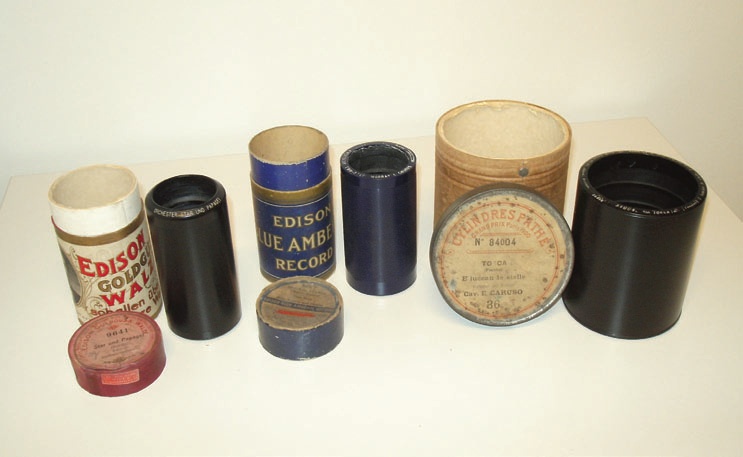
Figure 2: Replicated cylinders: wax (left), celluloid (centre) and wax “Pathé”.
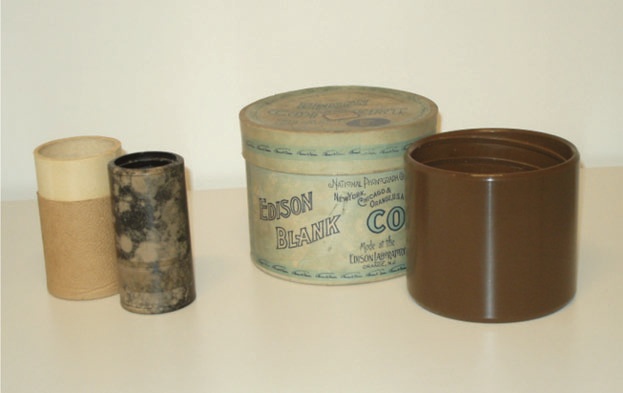
Figure 3: Self recorded cylinders: wax, affected by mould (left) and “Edison Concert” (right).
The various wax compositions used for wax cylinders are chemically fairly stable, if properly stored. Wax, however, is highly susceptible to fungus growths and, as many cylinders were inadequately stored in their earlier lives, fungal infection (mycosis) is commonly found. Fungi aggressively attack the surface of the cylinders and seem to aim for wax as their primary nutrition source. Additionally, the digestion process is associated with the secretion of acids and enzymes, further damaging the material of the cylinders. Complete removal is not possible. Prevention of further fungus growth is, therefore, of utmost importance. Chemical breakdown can also occur under the same conditions that promote fungus growth. Typically this takes the form of “efflorescence,” which can be mistaken for mould, but appears to involve the actual separation of constituent materials in the metallic soap composition.
Celluloid cylinders suffer from brittleness of their cellulose nitrate surface, but catastrophic deterioration as occurs in nitrate films has not been experienced. Mechanically, all wax cylinders and the plaster cores of celluloid cylinders are extremely fragile.
2.1.1.2 Coarse groove discs (gramophone discs)
Emile Berliner invented the gramophone in 1887. The groove is arranged as a spiral on the surface of a disc. Generally, the modulation of the grooves is lateral, as opposed to vertical for cylinders. Only a few disc formats (Pathé, Edison) have vertically cut grooves. The big advantage of the disc shape, apart from greater ease of storage, is that galvanoplastic negatives can be easily made and used for replication by pressing. As the number of pressings is limited, the first metal negative (“father”) serves only as a master for a metal positive (“mother”), which is used to produce an unlimited numbers of metal stampers (“sons”), which are used for the pressing tools for the replicated discs. This method, established at the beginning of the 20th century, is still being used for micro groove discs (“vinyls”), and for the production of replicated CDs, DVDs and BDs.
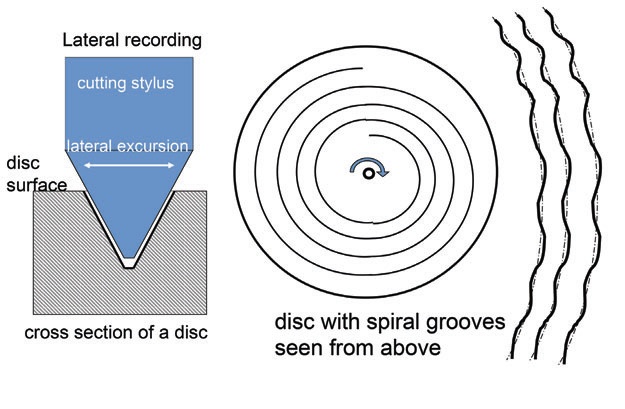
Figure 4: Coarse and micro groove discs recording principle.
2.1.1.2.1 Replicated coarse groove discs. The majority of coarse groove discs — the so-called shellac records — consist of a mixture of mineral powders bonded together by binders, originally containing shellac resin. These materials are chemically generally very stable if kept under fairly dry conditions. They are, however, fragile: when dropped, they break. Apart from shellacs, other record types existed in much smaller quantities and used different materials. These were often of lesser stability, for example, Edison Diamond discs, which are extremely susceptible to moisture.5
2.1.1.2.2 Instantaneous discs were recording media that were widespread in radio stations, before the advent of magnetic tape. The discs were used to record and replay signals without the need for galvanoplastic processing and pressing. Their surfaces are soft enough to permit the cutting of the groove, but hard enough to permit a number of replays. Most of these discs are unique recordings. If not recognisable by their distinct appearance, almost all instantaneous discs can be identified by their handwritten or typed labels.
There are homogeneous discs made from one single material component such as aluminium, zinc, PVC, or gelatine, as well as laminated discs, which are composed of a substrate and a surface coating made from different materials that is engraved with the recording.
2.1.1.2.2.1 Lacquer discs. The most widespread type of instantaneous discs is laminated: the lacquer or “acetate” discs. A lacquer coating consisting mainly of cellulose nitrate and usually plasticized with castor oil or camphor carries the information. The substrate that supports the information layer of the discs is generally of metal (e.g. aluminium or zinc); some are of glass, cardboard, or paper.
Lacquer discs can be easily identified as the base material can usually be seen between the outer lacquer layers, either within the centre hole or at the disc edge (IASA-TC 04, 5.2.2.5).
Cellulose nitrate decomposes continuously over time by reacting with water vapour or oxygen. This process produces acids that act as a catalyst for these hydrolytic reactions. Elevated temperature and humidity levels will further accelerate these reactions. Gradual degradation, along with loss of plasticisers, causes progressive embrittlement and shrinking of the lacquer coating. As the lacquer is bonded to a substrate that cannot shrink, internal stresses ultimately result in a cracking and flaking off of the lacquer coating, leading to the loss of the sound carrying layer. The mechanical instability of cardboard/paper bases often results in uneven or cracked surfaces while the fragility of glass bases often results in broken discs.
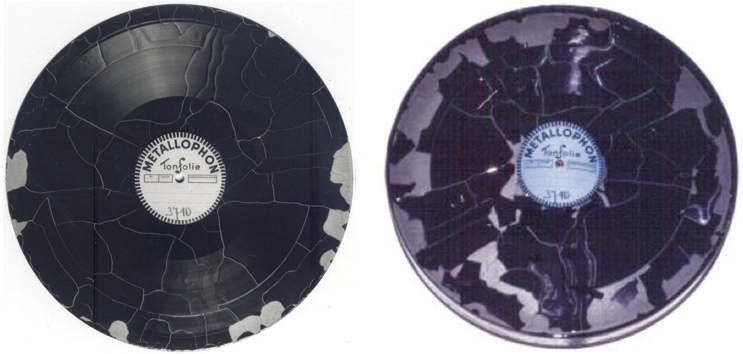
Figure 5: Metal based lacquer disc in the process of deterioration 1990–2001.
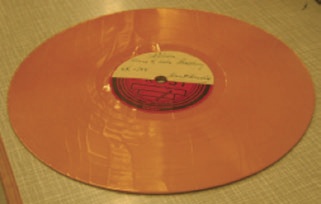
Figure 6: Cardboard based lacquer disc in the process of deterioration. (Stig-Lennard Molneryd)
Internal stresses are difficult to detect. Lacquer discs should not, therefore, be exposed to mechanical or thermal stresses. As their further life expectancy is unpredictable, the recordings on such discs should be immediately transferred to digital files before they are lost.
2.1.1.2.2.2 Other instantaneous discs. In addition to lacquer discs, all other instantaneous discs, irrespective of their particular composition, should also be considered to be at great risk.
5. For details of early coarse groove discs see St-Laurent 1996.
2.1.1.3 Microgroove discs (“LPs”, “vinyls”)
From the late 1940s onward a new material was used for replicated pressed discs: a co-polymer of polyvinyl chloride (PVC) and polyvinyl acetate (PVA) was introduced for two different new formats. The RCA record company launched a seven-inch (= 17 cm) disc that runs at 45 rpm for three minutes per side — in terms of duration, a continuation of the old shellac disc format. Columbia started the 10-inch (= 25 cm) LP, later enlarged to 12 inch (= 30 cm), both of which run at 331/3 rpm. Playing times are 15 and 25 minutes per side, respectively. This new material with its almost amorphous structure allowed much finer mechanical signal representation, which made narrower grooves, lower speeds and, therefore, longer playing times possible. The amorphous structure of the plastic also produced considerably less surface noise than shellac discs. PVC/PVA co-polymer, colloquially termed “vinyl”, is chemically very stable. Except for a few very early discs, an average vinyl disc is chemically in good shape. The material is comparatively soft, however, and therefore vulnerable to damage by scratching or abrasion.
In the early days of microgroove disc, small numbers were produced by injection moulding using styrene. These discs can be identified by their light weight and their relatively matte surface in relation to the shiny surfaces of “vinyls”. In reproduction, they have a higher surface hiss level than vinyl records. No systematic stability problems have been observed with this type of LP.
2.1.2 Deterioration by replay
2.1.2.1 General susceptibility. With all mechanical formats, mechanical replay will to some extent cause the shape of the groove to deteriorate. Specifically, cylinders and coarse groove discs played with historic equipment have often been damaged by the high inertia and excessive tracking forces of the old replay mechanisms. In addition, inappropriate stylus shapes and materials, and poor operation of the equipment, add to the groove damage. Microgroove discs also suffer from playback using low quality and/or misaligned equipment. As a result, most of the preserved mechanical records have not retained their original groove shape and sound quality. However, carefully chosen and adjusted equipment coupled with skilled operation permits the replay of all mechanical carriers without further deterioration.6
Cylinders, early shellacs, and all instantaneous discs must be handed over to experienced specialists. Shellac records from around 1930 onward and microgroove discs can be transferred by skilled staff with special training.
2.1.2.2 Alignment and maintenance of equipment. Pivoted tone arms of disc players need careful alignment of the following parameters:
- Effective tone arm length to minimise the (unavoidable) tangential tracking angle (TTA) error;
- correct setting of tracking force (“stylus pressure”);
- adequate skating compensation (“anti-skate”);
- correct adjustment of the height of the arm (parallel to disc during playback), which assures the correct vertical tracking angle (VTA), (see IASATC 04, 5.2.4, 5.3.4).
For tangential tone arms, alignment is restricted to the position of the stylus, and the tracking force.
Maintenance comprises:
- Frequent, careful cleaning of the stylus.
- Occasional cleaning of the platter and the driving belt.
- Tangential tone arms: occasional cleaning of the guide rails.
- Platter bearings: occasional lubrication with acid free low viscosity oil.
Only distilled water with mild detergent should be used for the cleaning of rubber and plastic components.
Modern cylinder replay machines must be aligned and maintained in close conformity to their manufacturer’s instructions and advice.
The keeping of log books for each piece of equipment and the careful documentation of all alignment and maintenance work is imperative.
6. Even wax cylinders will not suffer deterioration from a small number of replays by experts using good quality, modern equipment and well chosen pick-up styli. Optical replay of mechanical carriers has been explored by engineers for decades. One of the major arguments in favour —the avoidance of groove deterioration by mechanical replay—is, however, only of theoretical value. For optical replay and its potential see IASA-TC 04, 5.2.4.14.
2.1.3 Strategy for access to mechanical carrier collections
Because of their susceptibility to deterioration by replay, strategies have to be in place to restrict the replay of mechanical carriers to the absolute minimum. In pre-digital times, record collections of broadcasters and national libraries typically held at least two copies of mass replicated discs; one for access and one “untouchable” for preservation. Unique recordings on cylinders or instantaneous discs were transferred to magnetic tape of which at least two copies were held — again, one for preservation and the other for access. Such strategies must be pursued until long-term preservation through digitisation can be arranged (IASA-TC 04). In collections that have not been completely digitised, the request for access is often taken as a trigger to prioritise digitisation of that material.
2.2 Magnetic carriers
Magnetic recording was invented in the 19th century. Recording devices using steel wire or steel tape were used on a small scale in parallel to cylinders and gramophones. The technology became used on a greater scale with the development of magnetic tape in its modern form in the 1930s.
2.2.1 Recording principle
A magnetic carrier is moved across an electro-magnetic recording head. The head produces a magnetic field that varies according to the signal it receives from the recording device. This magnetic information is “frozen” within the magnetic carrier as it passes the recording head. The recorded signals can be retrieved by running the carrier across a replay head (sometimes identical with the recording head) that picks up the magnetic field and converts it back into an electric signal. With analogue audio tape recorders the head is stationary. Analogue video signals, as well as digital audio and video signals, require a considerably higher bandwidth than the analogue audio signal. This is achieved by greatly increasing the recording speed. This increase in speed cannot be done by simply moving the tape faster as the amount of tape required is excessive. The problem is generally solved by a rotating head which writes across the width of the tape with high speed, while the linear speed of the tape is much slower.
It is important to understand that, in order to optimally retrieve the signal from a tape, an intimate tape-to-head contact is essential, which is one of the reasons for keeping tapes, machines, as well as storage and handling areas, clean (see 3.5.1 and fig. 25).
For the specifics of hard disk recording, see 2.2.2.
By using the Kerr effect, magnetic information can also be read optically. This principle is used with magneto-optical carriers (2.3.1.4). It is also employed in the retrieval process of high-density computer back-up tapes. Reading conventionally recorded audio tapes by using this principle has not developed beyond an experimental state.
2.2.1.1 Magnetic tapes
In its present form magnetic tape recording was developed in the 1930s by AEG Telefunken and introduced for professional application in 1936. It became widely used within the German Radio. Because of World War II, however, its use was restricted to Germany. After the war it came to the United States from where it spread worldwide. In the late 1940s and early 1950s the use of this recording technology was concentrated mainly in the broadcast and recording industries. From the early 1950s onward, however, home audio recorders were developed which operated at slower speeds and employed half and quarter track formats to reduce the costs of magnetic tape. However, this was at the expense of recording quality. Also, during the 1950s, transistorised portable recording equipment became available that made sound recording possible everywhere in the world. This lead to a mushrooming of recorded sound collections, particularly in the fields of cultural, linguistic, anthropological, and ethno-musicological documentation. In the 1960s, cassette formats were developed. Of these, the compact cassette soon became the dominant format in the market, and is still in use.
In addition to magnetic tape, magnetic wire recorders were developed in the United States in the 1940s. They also gained some popularity in Europe in the 1950s and 60s.
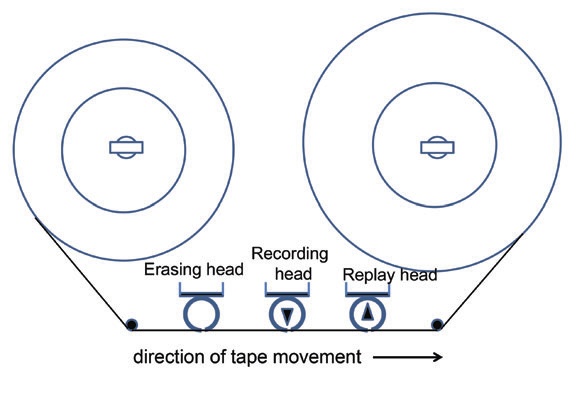
Figure 7: Principle of magnetic audio tape recording. In such “linear“ recording, the speed of writing is the same as the speed of the tape.
After several experiments, digital audio recording on magnetic tape was introduced in the 1980s. All of these early professional and semi-professional formats are now obsolete. In 1987 R-DAT (Rotary head Digital Audio Tape), a digital recording cassette format, was marketed and gained some popularity in semi-professional and professional circles. Since about 2005, however, it has also become obsolete. Now all audio specific magnetic tape formats are, in practice, dead. Audio recording, post production, and storage have become part of the IT (computer) world with its specific carriers and formats.
From 1956 onward, magnetic tape was also used for video recording. Several professional reel-to-reel formats were developed and in use until the late 1970s. They were followed by professional analogue and digital cassette formats. For home recording, early open reel formats were available from around 1970 and, around 1980, cassette home formats became widespread. Of these, the VHS format survived until recently. For small handheld camcorders (“handy cams”), an 8 mm cassette system became popular (Video8, VideoHi8), which was still in use in the early 2000s. Digital home formats were introduced in 1996. The Mini DV format dominated handheld camcorders from the early 2000s but has also become obsolete, replaced by optical, hard disc, and solid state (“flash card”) recording systems. The same development for the last remaining professional video tape formats is under way.
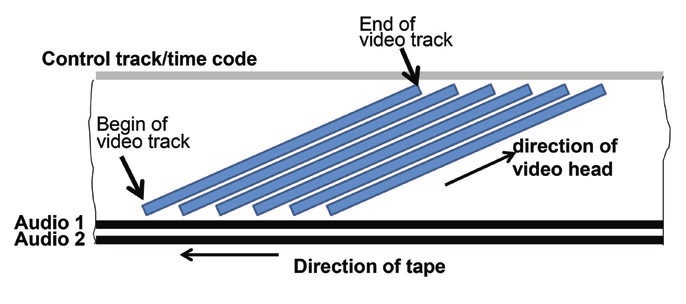
Figure 8: Principle of magnetic video recording. The high bandwidths of video signals require high recording speeds, which are achieved by a fast rotating head that writes narrow video tracks across a tape moving at a much slower linear speed. This principle of “helical scan” recording is also used for digital video formats and R-DAT.
Thus, video has developed in a similar way to that taken by audio. Proprietary video-specific formats are being replaced by file formats. Recording, postproduction and storage have, like audio, become part of the IT world.
Some video cassette formats have also been used for audio only recording purposes (IASATC 04, 5.5.7).
Beyond specific audio and video formats, magnetic media are the most prominent storage media in the IT world. Magnetic tape plays an important role as a computer backup medium and hard disc drives (HDD) have seen tremendous growth both in professional and home applications. Both carrier types have become the backbone of professional digital audio and video archiving. While this publication concentrates on (traditional) audio and video tapes, the basic principles described are valid for magnetic computer media.
2.2.1.1.1 Components of magnetic tapes and their stability
Magnetic tape is composed of two main layers: the base film and the magnetic layer. Additionally, many tapes are back matted for improved winding properties, and to reduce electrostatic charges.
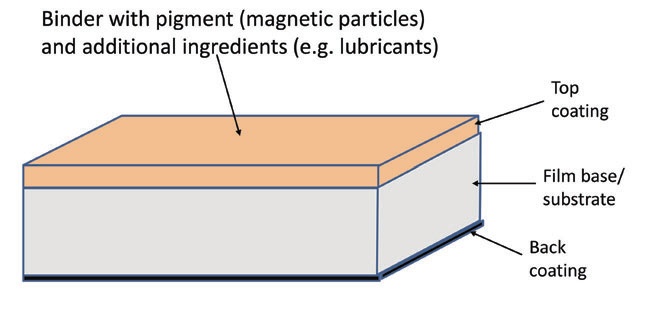
Figure 9: Layers of magnetic tape.
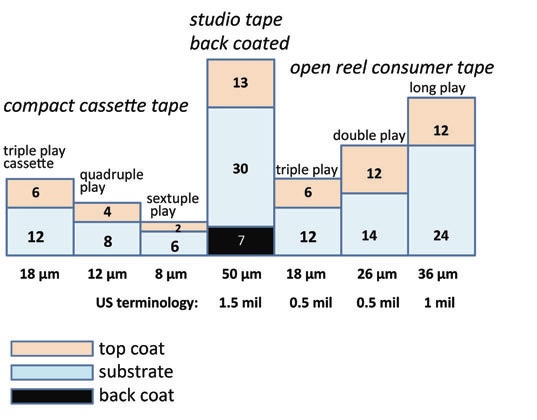
Figure 10: Cross sections of different audio magnetic tapes. Back coating may also be found on LP and DP tapes. (Friedrich Engel)
2.2.1.1.1.1 Base film materials. As magnetic tapes were developed, the following materials were used: paper, cellulose acetate (CA), polyvinyl chloride (PVC), polyester (polyethylene terephthalate, PET or PE), as well as polyethylene naphthalate (PEN).
Cellulose acetate was used from the mid-1930s until it faded out during the early 1970s. Such tapes can be identified by holding the tape pack against a light source: with some exceptions, it is translucent.
There are two processes of CA deterioration. One is hydrolysis, widely known and well researched in film preservation as “vinegar syndrome” (3.1.1.1). The other deterioration process is plasticiser loss: affected tapes become brittle.
CA audio tapes, in general, are much less affected by these deterioration processes than CA films. Specifically the vinegar syndrome seems to some extent to be a critical mass problem, which is less effective with audio tape. While hydrolysis is clearly related to high levels of relative humidity, which calls for low humidity storage, earlier literature (e.g. FIAF, 1.3, 11.2.4, 11.2.11.3) had recommended medium RH levels to prevent plasticiser loss. This is not confirmed by more recent literature.
CA audio tapes often also suffer from various geometrical deformations. As an intimate tapeto head contact is the basic requirement for optimal signal extraction, such deformations mean that the required contact cannot be achieved. Higher tape tension to improve tapeto- head contact is generally not applicable, as the tapes break because of their brittleness.7
It should be noted that severe cases of both kinds of deterioration—hydrolysis and embrittlement— mainly occur with German tapes from the early 1940s, and, more widespread, with tapes from East Germany and from the Soviet Union, produced well into the 1960s.
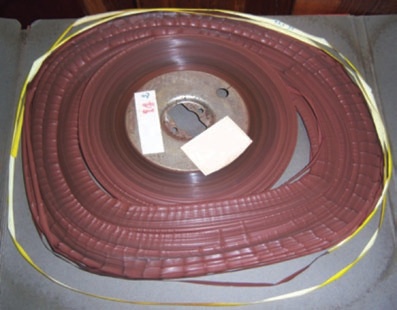
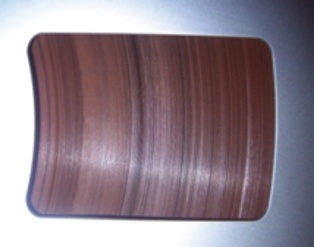
Figures 11 and 12: Typical brittle cellulose acetate tape before and after reconditioning (rewound on spool). The slipped tape pack can be rescued with the help of a “Wickelretter” (see 3.4.2.1 and figure 24).
Several other CA tapes are also affected. It should be noted, however, that some CA tapes from other production sources are still in good, flexible, and playable condition.
A comforting side effect of CA tapes is that they break without stretching (as opposed to PET, see below). This usually allows broken tapes to be spliced without the loss of recorded signals.
PVC tapes were mainly produced in Germany between 1944 and 1972 and as yet have not suffered from any systematic chemical deterioration. As plasticiser loss has not yet been experienced, tapes have maintained their flexibility. Due to their electrostatic behaviour, however, their winding properties are sub-optimal.
As practically all PVC tapes were produced in Germany, identification of professional tapes is easy because of the imprint on the back. Consumer tapes can be identified by the imprint on their leader tapes if the original ones have survived. Significant for all PVC tapes is their soft plasticity, which is a most welcome advantage when they are compared with CA tapes of similar vintage.
Apart from the early experiments in magnetic recording in Germany in the 1930s and occasional use after WW II, only a few paper based tapes were manufactured in the late 1940s in the U.S.
PET has gradually replaced CA and PVC tapes from the late 1950s onward. Since then, it has been used for all kind of magnetic tapes. It is mechanically fairly robust, and no systematic chemical deterioration of PET based films has been observed so far.8 However, unlike CA tape, PET elongates (stretches or “shoelaces”) before breaking, which leads to stretched tapes and unrecoverable signals. This calls for high precision replay machines and correctly adjusted tape winding, particularly when thin tapes are to be replayed.
Film base thicknesses vary between 30 µm for standard play audio tape down to 6 µm for thin audio and video cassette tapes. The thinnest CA and PVC bases produced are double play open reel tape (15 µm thickness), while thinner bases are possible with PET and PEN. PEN is used for thin digital video and computer back-up tapes.
In order to achieve stable bonding with pigment layers as well as back coating, base films are covered with thin layers (fractions of µm) of primers which are applied by the base film manufacturer or during the application of the magnetic layer.
2.2.1.1.1.2 Magnetic pigments. The very first magnetic pigment used in the 1930s was carbonyl iron. This was soon replaced, however, by a ferrous oxide (γFe2O3), which has been used for all open reel magnetic audio tape, compact cassettes of type IEC I, and the first video format (2 inch Quadruplex). γFe2O3 is brown rust and chemically stable. Because of the size of its elementary magnets, however, its capability to record the increased data density required by reducing recording speeds and tape widths was limited. In order to allow the development of smaller tapes still capable to handle the bandwidth of video signals, chromium dioxide (CrO2) was employed from the early 1970s. This permitted higher data densities, slower recording speeds and narrower tapes. Chromium dioxide and its substitutes (cobalt-doped Fe3O4) are dark grey in colour and have mainly been used for analogue video recording and for compact cassettes type IEC II. No critical observations have been made of chemical instability so far. From the mid-1970s, double layer cassette tape was produced: an iron oxide layer was covered by a thin layer of CrO2. Standardised as type IEC III, these cassette tapes gave improved signal-to-noise (S/N) ratios.
The latest magnetic pigment is made from pure iron particles (MP). It is used for digital video formats, R-DAT, and compact cassettes type IEC IV. Because of its chemical nature it is potentially prone to oxidation. After problems with early tapes in this respect, methods were developed that have prevented any widespread oxidation so far. However, in the midto long-term, MP tapes as well as ME tapes (tapes with a magnetic layer produced by evaporation under high vacuum) must be considered potentially endangered. MP tapes have a colour similar to chromium tapes with, however, a “metallic” reflectivity of their surfaces.
2.2.1.1.1.2.1 Stability of magnetic information. A constituent factor of magnetic information stability is the coercivity9 of a magnetic material. In the course of their development, magnetic pigments with ever-higher coercivity have been employed. The coercivity of carbonyl iron measures around 150 Oersted; average γFe2O3 tapes are between 300 and 400 Oe; CrO2tapes are typically 600-700 Oe; and MP and ME tape up to 1500 Oe. For data recording tape the coercivity can be above 2500 Oe.10
Apart from external fields, temperatures beyond the Curie point (3.2.1.5) and magnetostrictive action can destabilise magnetic orientation.
Magnetostriction is the disorientation of magnetic alignment by mechanical impacts. Except for very early Fe3O4 tapes, however, this effect is insignificant. Magnetostriction is positively employed for the erasure of unwanted print through signals on magnetic tape (IASA-TC 04, 5.4.13).
Contrary to widespread fears, magnetic information does not vanish with time. Properly produced, stored, and handled magnetic tapes will not lose their magnetic properties within historically relevant periods.
2.2.1.1.1.3 Pigment binders. Magnetic pigments are powders that need to be bonded together and onto the tape. In early tape production cellulose acetate was used, followed by copolymers of polyurethanes. Old CA binders are responsible for dry pigment shedding and are, therefore, regarded as a risk, as are CA tapes in general. In general, the bulk of the late 1950s and 1960s tapes have not shown severe binder deterioration problems.
Tapes from the 1970s and 1980s, however, frequently suffer from unstable pigment layers. This manifests itself as the shedding of the pigment layer in a sticky deposit—generally known as sticky tape or sticky shed syndrome (2.2.1.1.2).
2.2.1.1.1.4 Lubricants. Magnetic coatings also contain lubricants, generally fatty acids and esters, to minimise friction between the tape and the heads. The coating acts like a sponge that delivers lubricant through pores. The quantity of lubricant is greater for video than for audio because of the higher writing and reading speeds. The pores and, therefore, an adequate lubricant delivery, are determined by the calendering process in manufacture. Some lubricants have a tendency to exudate and crystallise on the tape surface, particularly stearic acid at temperatures below 8°C. This causes clogging of replay heads. Surplus lubricant can be removed mechanically, helped by elevated temperatures. Re-lubrication, as mentioned on several websites and publications, must be seen very critically, as it is impossible to restrict added lubricants to the small amounts actually needed. Superfluous lubricants are difficult to remove from tape guides, heads, and capstan and may interact with other tapes played on those machines at a later date (Schüller 2014).
2.2.1.1.1.5 Back matting originated in Germany to improve safe tape handling with flangeless hubs in radio studios. Back matting ensured a tight and safe tape pack without the risk of slipping apart. From the 1970s onward, back matting became more widely applied for audio and video tapes, generally by adding carbon black to improve conductivity to remove electrostatic charges which, together with the slight surface roughness, improves winding properties.
7. Several authors, however, report that the replay of brittle tape can be improved if stored for a period under high humidity conditions: vapour temporarily replaces the lost plasticiser. Recently, processes have been developed to make brittle tapes playable, refreshing the elasticity permanently by substitution of a plasticiser (Oesterreichische Akademie der Wissenschaften 2012, Wallaszkovits et al. 2014).
8. A theoretical breakdown scenario discussed in the 1990s did in practical use not materialise.
9. Coercivity is the property of a given magnetic pigment to resist changes in magnetic orientation or re-orientation (= "erasure"). It is defined by the level of the magnetic field needed for (re-)orientation, expressed in Oersted (Oe). The higher the coercivity, the higher the resistance of magnetic information to re-orientation (or erasure) by external magnetic fields.
10. In analogue audio recording these different coercivity values have been the major reason for the need to adjust the bias for each tape type.
2.2.1.1.2 The so-called Sticky Tape or Sticky Shed Syndrome (SSS)
From the mid-1970s onward, sticky tapes and pigment shedding have been frequently observed. These tapes often squeal during replay due to friction because of sticky pigment and binder particles deposited on tape guides and audio and video heads. This clogs the heads and leads to a significant loss of high frequencies (audio), or a complete breakdown of the signal (video).
Hydrolysis of pigment binders has been the most frequent explanation for these problems. Because this kind of hydrolysis is reversible to some degree, such tapes generally can be reconditioned for replay by exposing them to low humidity and elevated temperatures (or a combination thereof: for details see IASA-TC04, 5.4.3.4).
Recent research11, however, reveals that there are several additional possible reasons for the stickiness of tapes: primer exudation, surplus of dispersion agents, lubricant exudation, and, finally, uneven dispersion of hardener. Except for the latter, which is incurable, treatment similar to that of binder hydrolysis can be used: elevated temperature12 coupled with mechanical cleaning. This will help make tapes reproducible during a time window that is long enough to permit the transfer of their contents.
11. Schüller 2014.
12. Temperatures employed in such processes have varied between 60°C (for audio only) and 40°C. As elevated temperatures may mechanically distort tapes, which is specifically critical for video tapes, and may also have a negative influence on the further life of the tape, present thinking suggests to use the lowest possible temperature which is still effective.
2.2.1.1.3 Production process and individual integrity of a given tape as stability factors
Production process and individual integrity of a given tape as stability factors. While the chemical composition is an indispensable basis, the production process is regarded to be of even higher importance for tape stability: coating speed, proper dispersion of components, temperature and pressure of calenders are only some of the factors determining the stability of pigment layers. This may lead to a different performance between batches of the same type of tape, sometimes even with the same batch.
Additionally, the physical integrity of the tape surface plays an important role. Poorly serviced replay equipment can scratch the tape surface and create ports of entries for destabilising agents, such as humidity.
Chemical analyses are, therefore, of limited value in evaluating the quality and predicting the further life expectancy of tapes. Moreover: as the composition and production of tapes vary greatly, research results and recommendations valid for one type, or even only for a particular batch of tape cannot necessarily be extrapolated to others, let alone all tapes. In this respect generalising statements and/or recommendations by publications based on a limited number of normally not even identified sample tapes, should be regarded critically (Schüller 2014).
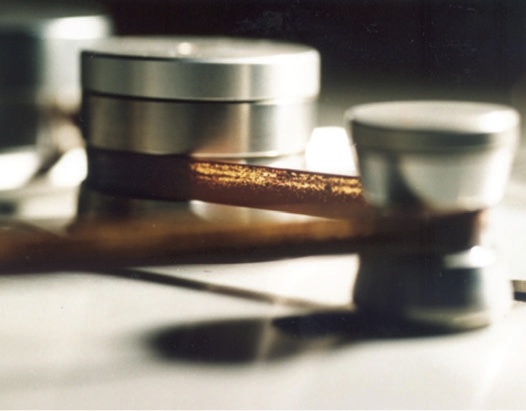
Figure 13: Pigment shedding: Chemical deterioration or poor manufacture?
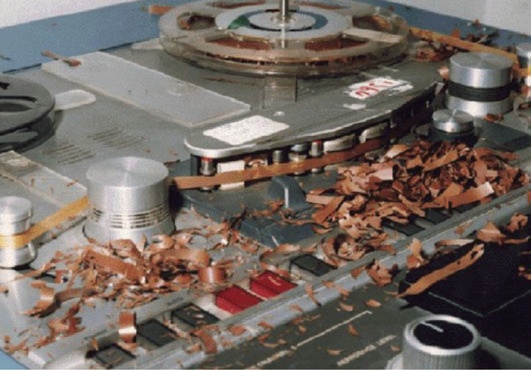
Figure 14: Rare case of total loss of pigment. This is most likely a production problem.
2.2.1.1.4 Deterioration by replay
Unlike mechanical carriers, fairly modern and well preserved magnetic tape can be replayed several hundred times without any measurable loss of quality. However, a pre-condition is well maintained replay equipment of the latest generation, which allows gentle handling of the carriers. Older or poorly serviced machines may severely damage, if not destroy, a tape during replay.
2.2.1.1.4.1 Alignment and maintenance of equipment (replay only). Magnetic tape players need careful alignment of the following parameters:
- vertical position, azimuth, and wrapping angle of replay head (Whenever head adjustment has to be changed to compensate for errors of the recording head of a given recording, it is imperative that the heads be re-aligned to their correct settings immediately after the playback is completed.);
- vertical position of tape guides to ensure horizontal tape travel and to avoid asymmetrical position of tape packs on reels and open hubs;
- calibration of tape tension in the play and winding modes, particularly if thin (amateur) and brittle cellulose acetate tape is to be played;
- alignment of the replay amplifier according to speed and equalisation standard (Alignment is head-dependent, therefore changing head blocks for different track formats will require re-alignment of the replay amplifier, or amplifiers switchable to different pre-settings.).
Maintenance comprises:
- the cleaning of tape heads and tape path (Frequency of cleaning is dependent on the abrasiveness of tapes in use. All surfaces of the tape path must be kept in perfect condition in order to avoid any scratching of the tape surface (2.2.1.1.3) as well as to avoid irregular speed fluctuations and to guarantee smooth tape-head contact.);
- frequent (daily) demagnetising of tape heads and tape guides (3.7.2.1.1);
- complete check of alignment and recalibration every 50-100 hours playing (not running) time.
The keeping of logbooks for each piece of equipment and the careful documentation of all alignment and maintenance work is imperative (IASA-TC 04, 5.4.)
2.2.1.1.5 Strategy for the access to magnetic tape collections
Although, in contrast to mechanical carriers, magnetic tapes can be replayed several hundred times without measurable deterioration of the recording, provided modern and well maintained equipment is employed, there is a statistical risk of damage to tapes through unforeseen malfunction of replay equipment. In particular, thin (LP, DP and TP) open reel tape and all cassette formats are prone to such rare, but unpredictable threats. In the analogue era this has led to a strategy of copying vulnerable original tapes to sturdy studio tapes and to making listening copies for recordings in frequent demand. Whether digital repositories are already in place or not, this strategy is still valid in the digital era, as most original digital audio and video recordings are extremely vulnerable. CDs and DVDs have proved ideal media for access copies (but not for master or preservation copies). As with collections of mechanical carriers, a request for access is often a trigger to prioritise the digitisation of that material.
2.2.2 Hard disk drives (HDD)
Hard disks (today generally called hard disk drives or HDDs) have been developed as computer storage devices since the mid-1950s. The prototype of today’s hard disks was the “Winchester” drive developed in 1973. Since the mid- 1980s, technical development has led to ever increasing capacities at continuously declining prices, which has made HDDs the main storage media, both for personal computers and, in particular, for mass storage systems. This development has also led to the decline in the use of recordable optical disks as storage devices after having been popular for audiovisual contents storage in the later 1990s and the early 2000s.
2.2.2.1 Recording principle and components. Hard disk drives consist of one or more rotating disk platters, normally made from aluminium, glass, or ceramics, covered with a thin (10-20 nm) ferromagnetic layer and mounted on a spindle. When in use, present day disks rotate at speeds between 4,200 and 15,000 rpm. A magnetic head, usually one, sometimes several, for each platter, writes and reads the information to and from the magnetic layer.
The head is mounted on a motor driven actuator arm, which permits the fast access of any part of the disk. In order to permit the closest proximity to the disk, yet avoid damage of the magnetic layer, the magnetic head is engineered with an aerofoil shape that allows it to ride on an air (or other gas) cushion that keeps it away from the surface. The head “flies” at a distance of fractions of a nanometre (just a few gas molecules in depth) from the disk surface in order to read short wave length signals. This spacing distance is important to avoid fatal head crashes caused by the head making contact with the surface of the disk. HDDs must not, therefore, be exposed to mechanical shocks during operation.
Until recently, longitudinal recording, comparable to recording on conventional magnetic tape, was standard. Since 2005, perpendicular recording has been introduced which permits higher data densities of three times or more than conventional longitudinal recording.
Originally rotating in air, platters in modern disks are also embedded in a helium atmosphere. The disk is sealed, which protects it to some extent from any intrusion of dust particles. Temperature is also a critical factor: manufacturers quote 40-55°C as maximum temperatures for safe disk operation.
2.2.2.2 Disk sizes. Today, the main sizes of hard disk drives are 3.5 and 2.5 inch. Smaller disks, developed for sub-note books are fading away, if not already obsolete, and are being replaced by solid-state memories.
2.2.2.3 Life expectancy. Life expectancy (LE) of hard disk drives is often referred to by “Mean Time Between (To) Failure” (MTBF or MTTF) which for current products is quoted to be between 1 and 1.5 million hours. However, these figures are extrapolated from laboratory tests and say nothing about the LE of a given medium. More realistic metrics of failure are AFRs, annualized failure rates, which quote the probability of a disk failure, expressed as the percentage of failing disks amongst a large population in relation to their age. Typical values quoted are below 10% for the first five years. Still, neither of these values allows a meaningful prediction of the actual life expectancy of a given individual disk. SMART pre-failure alerts are, however, highly correlating indicators of possible later failures if adequately monitored.
The practical commercial lifetime of a hard disk in a server environment, specifically its economic serviceability, is a key factor. Typically, hard disks are kept in operation between three and seven years.
Debates on HDD shelf storage over longer periods (several decades) have not led to any conclusive results.
To summarize, an individual hard drive is an inherently unreliable data carrier. However, storing multiple copies of each file in a well-managed mass storage system consisting of multiple hard disk drives with self-checking and self-healing protocols is an efficient and safe method of long-term storage (IASA-TC 04, 6.3.14-21).
2.2.3 Magneto-optical carriers (MODs)
While the information is stored magnetically, the recording and the reading process is optical. Because of their similar architecture with optical discs, MODs are discussed under 2.3.1.4.
2.3 Optical carriers
Optical carriers are the oldest audiovisual carriers. They have been in use for analogue image representation for more than 170 years. For the storage of audio and video signals, however, they are amongst the youngest group of carriers. Although optical tape formats have been developed, they have not reached market acceptance. Therefore, optical audio and video carriers are restricted to disc13 formats.
13. Spelling of disc vs. disk; this publication joins the orthography of IASA-TC 04, second edition: all analogue and optical discs are spelled discs; magnetic disks are spelled disk.
2.3.1 Recording principle
This is different to photographic carriers, which work by absorbing varying amounts of light. Optical discs rely on the creation of tracks of microscopic size that change the reflection of a laser beam, thus permitting the retrieval of the recorded signal.
The ancestor of optical discs was the Laser Vision Disc, which was developed for analogue video signals in the late 1970s. The technology and format parameters, but not the size, were taken over by the Compact Disc which was marketed as a replicated or pressed digital audio format in 1982 (CD-A, defined as Red book standard). It was soon discovered that, beyond audio, CDs would also be an ideal medium for the dissemination of general data, such as text, graphics and moving pictures, which in 1985 gave birth to the replicated data CD (CD-ROM14, Yellow book standard). In 1987 the interactive CD (CD-I, Green book) followed. By 1991 recordable CDs (CD-Rs, Orange book standard) and rewritable CDs (CD-RW, also Orange book standard) were developed. Finally, in 1993 a video CD standard (CD-V or VCD, White book standard) was defined, which has gained great popularity in East Asia.
In order to increase the capacity of optical discs, mainly to make them suitable for the storage of video films, the DVD (Digital Versatile or Video Disc) was introduced from 1995 onwards using the same recording principles as CDs. By reducing the laser wavelengths and thus reducing the track dimensions, the storage capacity was increased by a factor of 7 for each DVD layer. By 2005/2006, storage capacity was increased again to make optical discs capable of storing HDTV signals. Of the two competing formats, the HD DVD and the Blu-ray Disc (BD), the Blu-ray ultimately succeeded, while HD DVD was suspended. Blu-ray makes use of short wave lasers (“blue-violet laser”) which permits a further step in the miniaturization of signal representation and thereby an increase in data density.
Finally, magneto-optical discs (MOD) should be mentioned in this context. Originally used in the computer world for storing data, they have lost their earlier importance with the dramatic increase of storage capacity of hard disc drives (HDD) at ever lower prices. In the consumer world they have gained some popularity, however, in form of the (rewritable) MiniDisc (MD).
2.3.1.1 Replicated CDs, DVDs and BDs (-ROMs). These discs consist of a transparent body of polycarbonate, 1.2 mm in thickness, replicated by injection moulding using a negative metal “stamper”. The upper surface of this body carries a spiral track of “pits” (holes) and “lands” (flat areas) of varying lengths. The “pitted” surface is covered by a reflective layer of aluminium, which is covered by a protective lacquer. This surface also carries the content /label information. A laser “reads” the information from underneath: It is focused so that it hits the pits and lands that form the track. The depth of the pits is ¼ of the laser wavelength, which gives a change in the reflection of the laser beam at the transition between pits and lands. Such changes represent digital 1’s while no change represents 0’s.
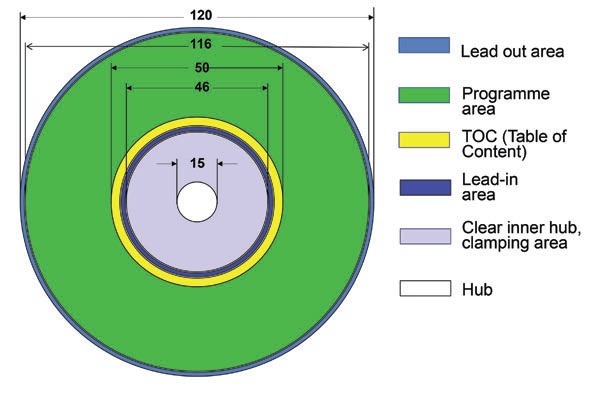
Figure 15: The partition of a CD-ROM; figures in mm.
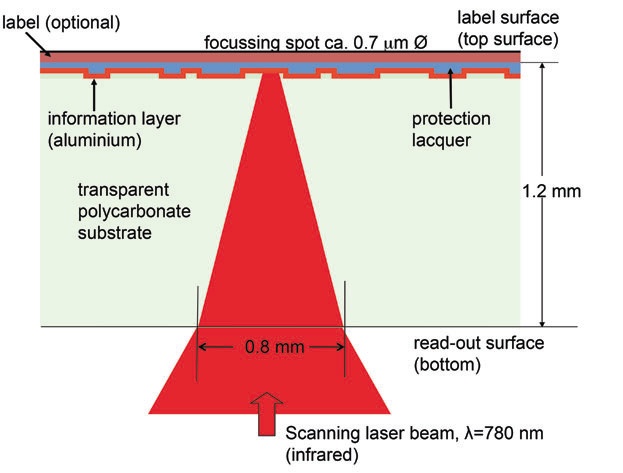
Figure 16: Layer structure and reading principle of a CD-ROM.
DVDs have narrower tracks and shorter pit/land lengths than CDs: they use a shorter wavelength laser. The basic disc is only 0.6 mm thick. With single sided DVDs, a blank second carbonate layer is bonded to the information carrying half. With double sided discs, a second information-carrying half is attached. Additionally, it is possible to add a second, semi-transparent layer (dual layer) to each data layer. This makes two layers readable from each side, almost quadrupling the storage capacity.
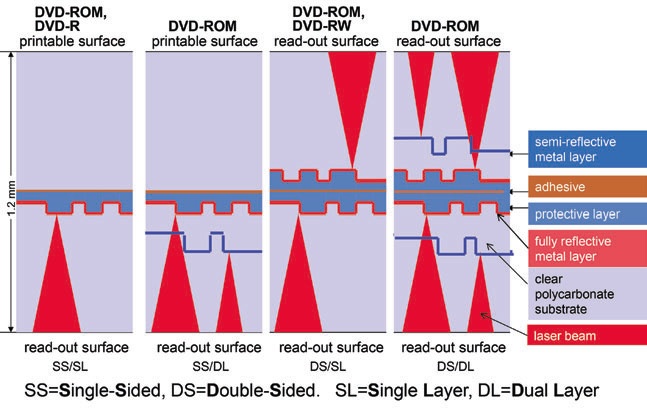
Figure 17: Layer structures of DVDs
Replicated Blu-ray discs (BDs) consist of two laminated polycarbonate bodies of different thicknesses. The lower, thinner one carries the pit-land track on its upper side covered by the reflective layer. The track is narrower than that of a DVD or CD. The upper, thicker polycarbonate body carries the label on its upper surface. Unlike DVDs, there are no double sided discs, but dual layer BDs are available.
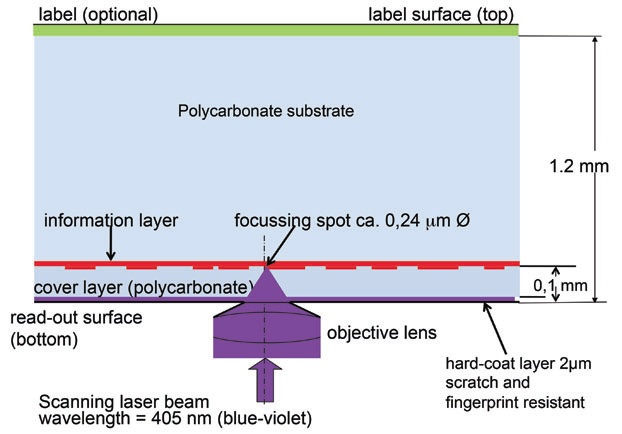
Figure 18: Layer structure of the Blu-ray disc.
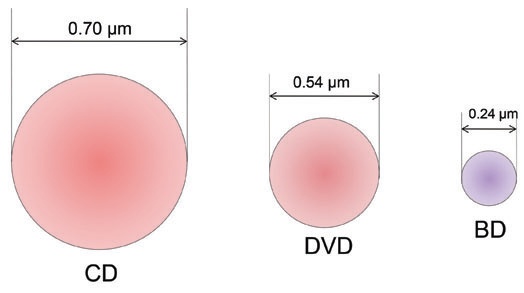
Figure 19: Focusing spots of CD, DVD, and BD.
2.3.1.2 Recordable optical discs (“Dye Discs”, CD-Rs, DVD-Rs, BD-Rs). The information layer consists of a groove in the upper surface of the polycarbonate body filled with an organic dye. Recording is made by a laser of much higher energy than the reading laser, which heats (“burns”) the dye. By this process, a sequence of burned and non-burned spots are created. The transitions between burnt and un-burnt areas are recognized by the reading laser in the same way as the pits and lands of replicated ROM-discs. Reflecting layers are of gold, silver, or silver alloy.

Figure 20: Injection moulded pits and lands (left) vs their burnt equivalents (centre and right) in CD-Rs (Jean-Marc Fontaine).
2.3.1.3 Rewritable optical discs (CD-RWs, DVD-RWs, BD-RWs). The information layer consists of a phase-changing metal alloy. Recording is made by a writing laser that heats up the metal alloy film at the exposed spot, inducing a phase change from crystalline to amorphous and vice versa, controlled by the burning temperature of the writing laser. Dielectric layers on both sides of the metal alloy film cause rapid cooling; the heated spots keep the changed phase after cooling. The amorphous film spots reflect the light of a reading laser with lower intensity than the crystalline areas allowing the transition between states to be recognised. Data can be erased and rewritten for a limited number of times (up to 1000 times).
2.3.1.4 Magneto-optical discs (MODs). The information layer is magnetic while the recording and reading process is optical. The recording is achieved by heating the magnetic information layer with a laser beam beyond its Curie point (3.2.1.5), which allows magnetic (re-)orientation by applying a very low magnetic field. The replay process makes use of the Kerr effect (see also 2.2.1), by which the magnetic orientation of the information layer causes different angle reflections of the reading laser. Actually magnetic carriers, for handling and storage purposes magneto-optical discs are grouped with optical discs proper, as their architecture is very similar.
Magneto-optical discs (more frequently spelled disks) were in professional use as a data back-up and transport medium in the 1990s. They came in different sizes (90 and 130 mm) and different storage capacities, and were housed in cartridges for protection against mechanical damage and foreign matter. With the development of hard disk drives (HDDs, 2.2.2) and their increasing storage capacities at ever-lower prices, magneto-optical discs have lost their importance.
2.3.1.5 MiniDisc (MD). The MiniDisc was introduced in 1992 as a replacement for the analogue compact cassette. It was popular for consumer use for over a decade, until its use faded in the later 2000s. It comes in two versions: as a magneto-optical disc (2.3.1.4) for recording purposes and as a replicated disc for pre-recorded content, which technically is like a CD-ROM. MiniDiscs are 2.5 inch (64 mm) in diameter and are housed in a cartridge, which makes them relatively resistant against mechanical damage and foreign matter. For their replay see IASA-TC 04, 5.6.10.
14. For the terminology of the classification of optical discs, this publication follows the recent development: originally replicated discs used for general data were called CD-ROMs (ROM=Read Only Memory). With the advent of recordable/rewritable CDs, this terminology became inconsistent. Recent publications on optical discs divide them into -ROM (replicated), -R (recordable), and -RW or -RAM (rewritable). All three types may contain audio, video, or general data.
2.3.2 The components of optical discs and their stability
The polycarbonate used for optical disc bodies is a transparent polymer with a low thermal expansion factor. It is resistant against deformation by heat at temperatures of up to 130°C. Early discs, especially LV discs, sometime had problems with crazing which made the polymer opaque and unreadable. From experience gained since the introduction of CDs in 1982, it can be expected that modern polycarbonate discs will be stable for several decades.
Apart from gold, all of the metals used to provide the reflective layers are prone to oxidation. Therefore, the protective lacquer layer of CDs plays an important role. It must be resistant against penetration of humidity, a function that often did not work properly with early CDs. Oxidised reflective layers, particularly aluminium, render optical discs unreadable.
The stability of the adhesive that keeps the two polycarbonate parts of a DVD or a BD together is unknown.
The stability of the dyes used in recordable CDs, DVDs and BDs is a factor of great uncertainty. There are three different dyes in use: cyanine, phthalo-cyanine, and azo. All dyes are susceptible to light, specifically uv radiation: an exposure of recordable discs to daylight will render them unreadable within a few weeks. Another uncertainty factor is the decrease in the amount of dye used for discs designed to run at higher recording speeds.
The life expectancy of dyes is often quoted to be between 5 and 100 years, an item of information that is of little practical use. The stability of the semi-transparent layers of DVDRs and BDs is unknown. Finally, the stability of rewritable discs is also unknown, and their potential life expectancy as compared to dye discs is unclear.
2.3.3 Deterioration by replay
There is no (measurable) deterioration by replay with optical discs.
2.3.4 Alignment and maintenance of equipment
Optical disc readers are non-adjustable mass-produced products, which is part of the problem explained below (2.3.5). Maintenance is restricted to occasional cleaning of the lens with the help of a cleaning disc, and of the loading tray.
2.3.5 Recording quality as a constitutive factor of life expectancy of recordable optical discs
Recordable optical discs (CD-Rs, DVD-Rs, BD-Rs) have become very popular media for audio, video, and data recording. As with many other digital carriers, their reliability depends on a sophisticated error correction system that permits the full reconstruction of the information even if small parts of the medium have become unreadable because of damage or deterioration by ageing. The correction capability is limited and, therefore, the quality of the recording becomes an important factor of life expectancy. A perfect, almost error free recording leaves more correction capacity to compensate for handling and ageing effects and, therefore, enhances the life expectancy. If, however, optical discs start their life with a high error rate, then there is little capacity left to compensate for further errors. The life of such discs will be shorter. Consequently, IASA has defined recommendations for maximal acceptable errors for optical discs in order to maximize their life expectancy, whatever it may be (IASA-TC 04, 8.1.9).
A major problem in burning recordable optical discs is the interaction between blanks (unrecorded discs) and writers. There are no standards defined, and the processes of automated adjustment do not always work sufficiently well. Tests have shown that randomly chosen blank/writer combinations produce 50% acceptable, and 50% unfavourable results. Consequently, to reliably burn recordable optical discs would need extensive testing of writer/blank combinations, control of each single disc produced, and further checking at regular intervals. As testing is labour intensive and test equipment is expensive, more reliable and, ultimately, more cost effective storage systems than recordable optical discs are used for professional data storage.15
15. J.-M. Fontaine, 2000.
2.3.6 Formats and sizes
Analogue Laser Vision Discs were manufactured in 300 and 200 mm sizes, mainly double sided, i.e., two discs bonded together back-to back. For the digital disc family, diameters are 120 mm for all types of discs apart from some CDs and BDs which are available in 80 mm diameter.
2.4 Solid state carriers
Solid-state memories are electronic circuit storage devices without any moving parts. These have been developed since the 1950s using various technologies. Of particular interest in the context of this publication are the so-called flash cards, developed since the 1990s. As removable data carriers they come in various formats (SD and several others) and as so-called USB-sticks. With an increase in storage capacity, accompanied by a dramatic drop in price, they have become popular as removable data carriers and, more recently, as replacement for HDDs in lightweight notebooks.
2.4.1 Recording principle and stability. Flash memories belong to the group of non-volatile solid-state memories, which retain their information without power supply. The memory cells consist of transistors, which can hold their information for many years. While reading capacity is generally described to be indefinite, programming/erase cycles are quoted to be between several thousand up to one million. Because of their relative sturdiness against mechanical shock and extended temperature ranges, they were originally employed in military applications.
As to their life expectancy, no realistic guesses are available. This is of minor interest as long as prices are significantly higher than HDDs. This makes them (still) unattractive for longterm storage. Although, in general, flash memories have proved their robustness for short term storage, specifically for location recording even under adverse conditions, it is imperative not to rely on a single carrier but to copy the contents at the earliest opportunity to another storage medium before arranging transfer to a secure digital storage system.
3 Passive Preservation: Environmental Factors, Handling and Storage
Water/humidity (section 3.1)
Temperature (section 3.2)
Climatic storage conditions (section 3.3)
Mechanical deformation (section 3.4)
Dust, foreign matter, (air) pollution (section 3.5)
Light, ultraviolet radiation, x-rays (section 3.6)
Stray magnetic fields (section 3.7)
Each section covers the various carriers: mechanical, magnetic, optical, and solid state.
3.1 Water/humidity
Water is the greatest natural enemy for all audiovisual carriers. It has direct chemical and indirect influences on the stability of carriers. Direct chemical influences are hydrolysis and oxidation of several carrier components as well as dissolution of some carrier materials.
3.1.1 Hydrolysis is a chemical reaction involving water, omnipresent in form of humidity in the air, as the central agent. Some polymers are prone to hydrolysis. Acids and metal ions act as catalysts in supporting such processes. The reaction changes the chemical and the physical properties of the original polymer, often producing a by-product that acts as an auto-catalyst that enhances the destructive process. Some hydrolytic processes are (partly) reversible; others are not.
3.1.1.1 Vinegar syndrome. A widely known hydrolytic polymer breakdown is the so-called vinegar syndrome. This process that deteriorates cellulose acetate (CA) films beyond retrievability, was first observed in the late 1940s. It has, however, been more widely experienced since the 1980s, particularly in tropical film archives. Acetic acid is one of the products of the process of hydrolysis of CA and acts as an auto-catalyst to accelerate the chemical reaction. Because of its smell it has become known as vinegar syndrome. With the advancement of the process, affected films lose their structure and become unplayable.
Magnetic film sound carriers with a base of CA are particularly at risk because of the catalytic properties of metal in the form of the iron oxide used as the magnetic pigment. Cellulose acetate audio tapes are also affected, but not, however, to the same disastrous degree as films because of their sub-critical mass. Apart from smell, acid detection strips assist to objectively assess the process. CA hydrolysis is not reversible.
3.1.1.2 Pigment binder degradation. Some binders of modern magnetic tapes (2.2.1.1.2) are also prone to hydrolysis causing the tapes to become sticky. Because the symptoms of this kind of hydrolysis are reversible to some degree, such tapes can generally be reconditioned for replay by exposing them to low humidity and elevated temperatures or a combination thereof. For details see IASA-TC04, 5.4.3.3. Recent research has, however, revealed that hydrolysis of binder is only one of several reasons for the so-called sticky shed syndrome (2.2.1.1.2).
3.1.2 Direct contact with water. Direct short contact with water is only dangerous for some kinds of instantaneous discs such as those made from gelatine, cardboard etc, and for hard disk drives. For other carriers water is not immediately dangerous, as long as the contact is short, the carriers are carefully cleaned if the water was dirty, and the carriers are thoroughly dried soon after coming into contact with the water. In fact, cleaning with de-ionised water is a recommended step in preparing vinyl and shellac discs for replay using a professional disc-cleaning machine (IASA-TC 04, 5.2.3, 5.3.3).
The major problem with carriers exposed to water influx is the logistical challenge of cleaning and drying the contaminated carriers, particularly for magnetic tape cassettes. Another logistic problem is the separation of carriers from paper and carton materials, such as LP albums, and the drying of those, before they become affected by mould. If greater quantities are affected, vacuum freeze drying, successfully developed for the rescue of paper and book materials, may be the only chance to safeguard paper and carton materials accompanying audiovisual material. The applicability on audiovisual carriers themselves and specifically on magnetic tape, has, as yet, not been sufficiently investigated (for influx prevention see 4.2).
3.1.3 Oxidation is another chemical reaction triggered by water. It is a potential threat to non-oxidic, pure metal particle magnetic pigments as used for compact cassettes type IEC IV, for R-DAT and for most digital video formats (2.2.1.1.1.2). Oxidation also affects the reflective layers of optical discs, except for those made of gold.
3.1.4 Dimensional influences. Humidity has also an influence on the dimensions of materials used as components of audiovisual carriers. For CA tapes, the humidity related expansion coefficient is quoted to be 15 times higher than that for polyester based tapes.16 A considerable dimension change must also be taken into account for several materials used for instantaneous discs, such as cardboard, gelatine, or the information carrying lacquer.
3.1.5 Indirect influence through bio-degradation. Water causes bio-degradation, specifically mould (fungus growth), which happens at prolonged exposure to relative humidities (RH) of 70% and higher. Fungi of various kinds are present everywhere in the world and affect nearly all audiovisual carriers. Fungi “eat” the surface of analogue mechanical carriers, which leads to excessive surface noise—a particular problem with wax cylinders. Fungi grow on magnetic tape pigment layers, which renders replay difficult or impossible. Fungi are also known to affect CDs, rendering them unplayable. Chemical prevention of fungus must be seen as a last resort. Unfavourable chemical interactions, particularly with the variety of magnetic pigment binder formulations that exist, can never be excluded. Chemical treatment may also endanger the health of archive staff.
Because of its potential for unfavourably influencing carriers, both directly and indirectly, fungus growth must be prevented by keeping relative humidity low. Any direct contact with water, even when permissible in principle, must be kept as short as possible.
3.1.6 Humidity/temperature interrelation. It must be noted that relative humidity and temperature are interrelated (for more details see 3.2.3).
3.2 Temperature
3.2.1 Physical influences.
3.2.1.1 Dimensional influences. Temperature influences the size of materials: generally, carriers expand with rising and shrink with falling temperatures. This is also true for tapes. Polyester tapes have the lowest thermal expansion coefficient, while that of CA is quoted to be three times higher.
With CA and PVC tapes, this leads to looser tape packs if temperatures rise and to tighter packs with lower temperatures. With PET base films, however, there is one anomaly: these are pre-tensilised which causes their thermal expansion coefficients to be significantly higher in the dimension of thickness than of length. Thus, wound-up PET tapes “swell” with rising temperatures — each layer of tape becomes thicker — which is not compensated by elongation. This increases the tension within the tape pack. Conversely, PET tapes become 16 FIAF 1986, 11.1.1.2. looser with falling temperatures. This calls for different relaxation measures for CA and PVC tapes to those for PET tapes when changing climatic storage conditions (3.2.4).
Dimensional changes are particularly dangerous for lacquer discs. Because of the different thermal expansion coefficients of the metal or glass substrate and the brittle lacquer coating, a temperature change may trigger the cracking of the latter.
Because of these disadvantages and potential threats, specifically for tape materials and lacquer discs, the stability of temperature is of greater importance than the chosen absolute value (see 3.3).
3.2.1.2 Irreversible influences on polymers. For some polymers used as components of audiovisual carriers, elevated temperatures have an irreversible influence. If heated beyond certain temperatures, their properties are changed and are not restored after lowering the temperature again. Temperature thresholds differ widely for various materials, but it can be stated that temperatures up to 35°C do not cause any immediate irreversible effects or lead to any deterioration of any current audiovisual carrier.
3.2.1.3 Thermoplastic materials. This group of polymers softens at higher temperatures. These polymers are used for the production of containers, cassette shells, etc. The inadvertent exposure of such materials to elevated temperature, even to sunlight, may lead to an irreversible deformation. This is also a specific threat to vinyl discs.
3.2.1.4 Print-through. Temperature influences print-through on magnetic tape: the rise of print through versus time is steeper with higher, and flatter with lower temperatures (see 3.7.2.5).
3.2.1.5 Curie point. Magnetic stability (coercivity) depends on temperature. At and beyond the Curie point, magnetic stability is lost. The lowest Curie point of widely used magnetic pigment is 128°C for CrO2, while the point for iron and iron oxide is above 300°C. This phenomenon, however, is positively employed in magneto-optical recording (2.3.1.4).
3.2.1.6 Temperature range. In order to extend life expectancy, photographic materials are often stored at temperatures below the freezing point. For magnetic tape, cold storage is discouraged because some, not all, lubricants exudate at a temperature below 8°C (2.2.1.1.1.4). At the higher end, 35°C should not be exceeded (3.2.1.2). Within this range, temperature only affects the physical dimensions of carriers and the speed of chemical processes.
3.2.2 Indirect chemical influence. Temperature determines the speed of chemical processes and, therefore, ageing or deterioration. Subject to the limits set out in 3.2.1.6, it can be stated as a rule of thumb that the speed of chemical processes is doubled by an increase of 10°C, or, on the other hand, the speed of ageing is slowed by 50% by lowering temperature by 10°C — a doubling of life expectancy.
3.2.3 Humidity and temperature interrelation. Temperature determines the absolute amount of water air can hold in gaseous form (vapour). Higher temperatures hold higher amounts of vapour, while lower temperatures hold less. If a given room is cooled without simultaneously dehumidifying the air, the relative humidity rises until 100% RH is reached. At this temperature, called the dew point, superfluous vapour condenses in the form of water on the coldest surfaces (see figure 30). Any air conditioning must, therefore, control both parameters simultaneously (see 4.3). Most conventional air conditioning equipment does not dehumidify sufficiently, thereby inadvertently raising relative humidity and increasing the threat to carriers, counter-acting the benefits of the lowered temperature
3.2.4 Temperature/humidity changes, as already mentioned in 3.2.1.1 above, can be more dangerous to carriers than stable, but sub-optimal, absolute values. Changes in temperature, but also in humidity, cause dimension changes, resulting in unnecessary stress to carriers. At highest risk are discs composed of different materials, e.g. lacquer discs, but magnetic tapes are also affected, specifically high density helical scan formats. The other basic danger is the possibility of condensation when bringing cold carriers into a warm environment.
Consequently, permanent storage conditions should be designed to have minimal temperature and humidity changes. During transportation, carriers must be protected by adequate logistics and containers (see 4.8). Changes of climatic parameters of longer duration require acclimatisation (staging) periods. For all materials, except lacquer discs, the temperature gradient should not exceed 3°C and the relative humidity gradient 5 percent points over a period of 24 hours. Additionally, to compensate for the different tensions within tape winds due to temperature changes (3.2.1.1), tapes must be relaxed by re-winding when bringing CA and PVC tapes to cooler storage conditions and PET and PEN tapes to warmer storage conditions. Lacquer discs, because of the threat of crackling due to different expansion coefficients between coating and substrate, are threatened by moves in both directions. Such transports should, therefore, be kept to the absolute minimum and be accompanied by long acclimatisation (staging) periods over several days.
The danger of condensation when bringing cold carriers into warmer areas must not be underestimated. Sufficient airing must be allowed until the carrier temperature is equalised.
3.3 Conclusions for the choice of climatic storage conditions
Conclusions for the choice of climatic storage conditions. On the basis of the above discussion, it becomes clear that the choice of storage conditions is mainly determined by two conflicting principles: to keep humidity and temperature low (to retard chemical deterioration), and to avoid climatic changes (to prevent condensation and to minimise mechanical stress, most importantly for tapes and lacquer discs).
The minimum/maximum values to be kept to are:
| Humidity | Absolute maximum for prolonged exposure | 60% RH |
| Minimum | 25% RH | |
| Temperature | Absolute maximum | 35°C |
| Minimum | 8°C for magnetic tapes |
As explained, the precise values between these maxima/minima, have no immediate negative or positive influence. However, in the mid- and long-term they determine the life expectancy of carriers. Of higher importance, however, is the stability of the chosen climatic conditions (3.2.1.1, 3.2.3, and 3.2.4).
For the purpose of storage recommendations, the following definitions are made:
| Humidity (ranges) | Medium | 40-50% RH |
| Low | 25-35% RH | |
| Variability1 | narrow ± 3%RH relaxed ± 5%RH |
|
| Temperature (mean values) |
Room2 | ~20°C |
| Cool | between 8 and12°C | |
| Variability3 | narrow ± 1°C relaxed ± 3°C |
1 Permissible variations around the mean values are low frequency (annual) deviations.
2 This mean value of “room temperature” condition reflects the situation in moderate climatic zones and is not necessarily obligatory for tropical countries. There, it may be prudent to choose a higher mean temperature, e.g. 25°C, and invest the saving in energy costs in effective dehumidification instead. This will also improve the well being of archival staff members, who generally may not find first-world climatic working conditions acceptable.
3 Permissible variations are low frequency (annual) deviations.
Please note: Temperature/humidity ranges and variability must not be added. The chosen mean value should be kept to the permissible variability.
Recommended storage conditions
| Collections | Humidity | Var | Temp | Var |
|---|---|---|---|---|
| Access storage Tape collections in frequent use Mechanical and optical carriers (except lacquer discs) |
low
medium |
narrow
relaxed |
room
room |
narrow
relaxed |
| Preservation storage Tape collections Mechanical and optical carriers (except lacquer discs) |
low
medium to low |
narrow
relaxed |
cool
room to cool |
narrow
relaxed |
| Access and preservation storage Lacquer discs |
medium | narrow | room | narrow |
The climatic conditions of studios and laboratories should be the same as, or very close to storage conditions. Whenever possible, work with carriers (e.g. routine inspection) stored at cool and low humidity conditions, should be carried out on the spot; otherwise, carriers must be adequately acclimatised.
The choice of target values for humidity and temperature is always a compromise between accessibility, comfort, and the health of operators on the one hand, and costs on the other. It must be further noted that even the lowest affordable values do not prevent, but only retard deterioration. Therefore, archives should choose those parameters that they can afford to keep 24 hours a day all year round. Within the permissible ranges, stability is more important than the absolute values of temperature and humidity.
3.4 Mechanical deformation
Mechanical deformation is a major threat, which affects all kinds of audiovisual carriers.
3.4.1 Mechanical carriers
Fragile carriers (cylinders, shellac discs) must be given special attention when handled and transported. Extreme care should be given when mounting of cylinders on replay machines equipped with mandrels. Invisible cracks may lead to the bursting of such cylinders when mounted with too high a pressure. Additionally, keeping cylinders in mobile shelves is inadvisable. Best transport protection is achieved by tight packing within shock absorbing containers.
All mechanical carriers are prone to surface damages, which will cause audible artefacts (clicks, crackle, etc.). Additionally, the information carried by the grooves is specifically threatened by maladjusted mechanical pick-up systems and wrongly chosen styli. Both may cause considerable damage (IASA-TC 04, 5.2 and 5.3).
Because of the susceptibility of all mechanical carriers to physical damage, their handling requires staff with manual skills and special training.
3.4.2 Magnetic carriers
3.4.2.1 Magnetic tape. Mechanical integrity is a commonly underrated factor in magnetic tape preservation. In order to minimise stress, particularly with brittle CA tapes and all kinds of thin tape, tape handling must be optimised by using the latest generation of replay equipment that permits lower tape tension while still providing intimate tape-to-head contact. Such equipment will also allow fast winding at relatively slow speeds (“library wind”).
Most importantly, all open reel and cassette tapes must be stored with absolute flat winding packs only, as any stepped wind will create curled tape edges. Generally, one of the two tape edges is the reference in guiding the tape through the machine, especially with rotary head formats. Any malformed edges will result in vertical tape movement causing a variety of replay artefacts such as oscillation of stereo balance in audio or “flicker” through tracking problems in video recordings. Flat winds can best be achieved by winding the tape forward after use to its end and then back over its entire length in one continuous pass at library wind speed. Machines generally failing to achieve flat winds must be serviced or exchanged. Some tapes, however, may resist the production of a flat wind even with the use of a library wind option. In these cases, the tape should be played at a high replay speed to achieve a flat wind for storage.
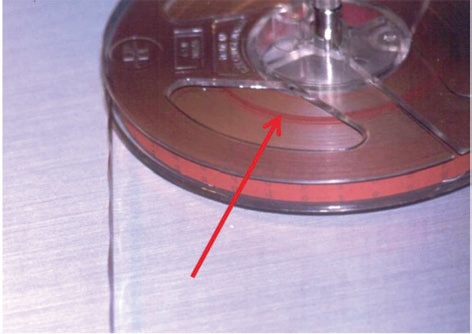
Figure 21: Tape rewound before its end. The step left in the wind will cause a deformation in this area. For flat tape winds, tapes and cassettes have to be rewound over their entire length.
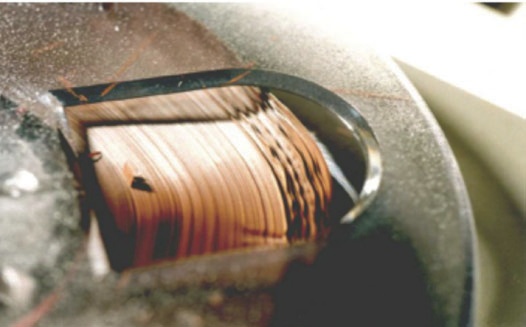
Figure 22: Uneven tape wind causing tape edge deformation.
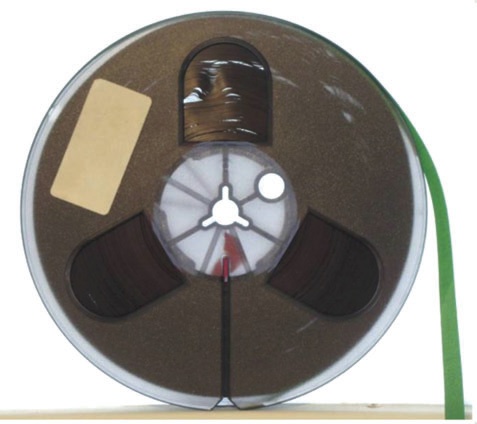
Figure 23: “Windowing“. Manual intervention may be needed to get a flat wind without damaging the tape through friction by slipping tape.
Flanges of plastic and metal reels must be absolutely flat to avoid touching the tape during replay and specifically in the fast wind mode. Additionally, tape guides must be adjusted to ensure tape packs are formed in the middle of hubs, avoiding squeezing tape towards one of the flanges. Slots in the hubs to take up leader tapes have often led to a permanent deformation of several winds of tapes after many years of storage. Misshapen reels must be replaced, preferably by ones with slot-less hubs. Permanent slot marks can also be removed by a slightly different placement of the leader tape into the slot. Regular repositioning, however, would be needed to avoid new deformations.
The use of flangeless hubs originated with the original German “Magnetophon” of the 1930s and was maintained for studio and radio applications in continental and Eastern Europe thereafter. Its application requires back-matted tapes, machines with adequate tape tension control in all operating modes, and, above all, careful and skilled handling. Such freely wound tapes are stored on their hubs, hanging on a suitable suspension in the centre of the box. It may happen, however, that the tape pack falls apart, due to pressure on the hub, or a loose wind (see figure 11). Restoration of the tape wind calls for manual skill and patience. Special devices, known as “Wickelretter”, which have hinged, sectional hubs that can be moved inwards to fit inside the pack and then moved outwards again to hold the tape pack while slowly rewinding the tape on to a new spool.
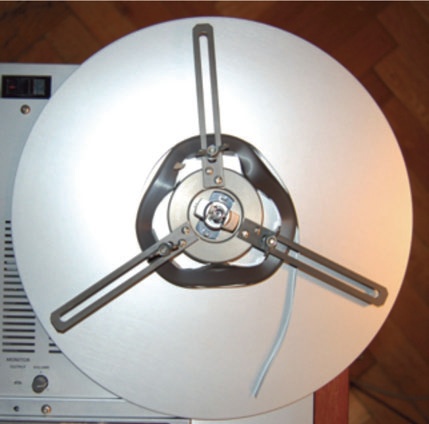
Figure 24: “Wickelretter” - device to assist the rescue of tape packs if hubs had slipped out.
Once CA tapes become brittle, they often have a tendency to “escape” from a flat pack during fast wind. It is, therefore, a wise precaution to wind them onto spools.
With cassette tapes, the loading and unloading procedure constitutes a significant stress to the tape resulting in measurable drops-outs after several tens of such actions. Also, malfunctioning mechanisms may jam and damage, if not destroy, the tape. Consequently, cassettes must only be loaded and unloaded at the unrecorded portions at the beginning or at the end of tape. If this is done, tapes that get jammed can be repaired by cutting off the damaged part without loss of recorded material. Therefore, when recording a programme on a cassette, sufficient room should be left blank as a loading area at the beginning and the end.
Regular cleaning of tape guides and heads—at least daily—must be performed using tools soft enough to avoid damage to heads and guides. Such damage will scratch tape surfaces, which endangers its chemical stability (2.2.1.1.3).
3.4.2.2 Hard disk drives. Generally, because of their moving parts, hard disk drives should not be exposed to mechanical shocks. Moreover, it must be noted that shock damage is more likely under operating than in non-operating conditions, when the read head is safely parked away from the hard disc surface. Hard disk recorders must always be handled with great care, particularly during recording and play back.
3.4.3 Optical discs
Optical discs must be kept free of mechanical damage and scratches. Scratches on the read-out surface will obstruct and/or divert the laser beam, while a damaged protective layer on CDs and BDs will endanger the chemical integrity of the reflective layer. Writing on protective layers (label side) can only be done on recordable discs and then only by using special CD felt pens. Ordinary felt pens must not be used as their solvents may dissolve the protective lacquer. Writing with hard tipped pencils or ballpoint writers may mechanically disturb retrievability. Bending of optical discs must be avoided, as this may crack the reflective layer. Consequently, when releasing optical discs from the centre holding clamp, two hands should be used — one to release the holding mechanism and the other to remove the disc.
3.4.4 Solid state carriers
Daily experience with solid-state data carriers suggests a level of robustness against some shocks, e.g. when dropped on the floor. It should be borne in mind, however, that due to their microscopic structure, some mechanical stresses, e.g. bending memory sticks in pockets, may lead to their immediate destruction.
3.5 Dust, foreign matter, (air) pollution, pests
3.5.1 Effects. Dust and foreign matter have a variety of effects on audiovisual carriers: with mechanical carriers they cause deviations of the stylus, resulting in audible artefacts (clicks). With magnetic tape, dust and foreign matter can clog the replay head and prevent intimate tape-to-head contact which, in audio, causes high frequency loss and, in video, the swift breakdown of the signal. With optical discs, the reading laser is obstructed which may lead to un-correctable errors and, eventually, muting.
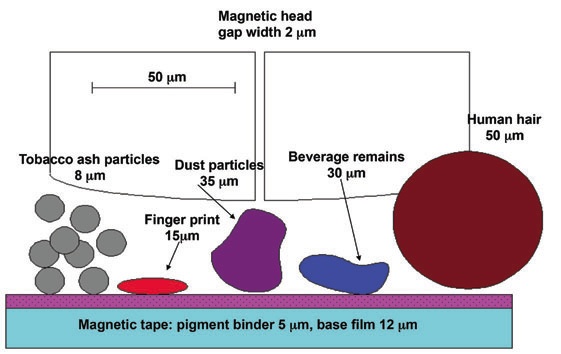
Figure 25: Proportion of foreign particles of different size obstructing intimate tape-to-head contact.
3.5.2 Origin and prevention. One of the major origins of dust pollutants is mineral dust. This is a particular problem in arid countries. Archives in such locations must be equipped with tightly sealed windows and doors, which may need enhancement by air locks at entrances. Another prominent source in urban environments is textile particles. Carpeted floors as widely used in offices in the 1970s are, therefore, absolutely forbidden throughout the entire audiovisual archive. Floors should be of concrete, covered or sealed with chemically inert materials or lacquer, or of non-abrasive minerals (terrazzo-type). The floor should be of a colour that makes the typical local dust visible and does not camouflage it. Dust prevention is best achieved by mechanical filters in the air conditioning equipment. Additionally, a slightly higher pressure in storage and laboratory areas helps prevent the intrusion of dust into sensitive areas by creating an airflow out of the building through any cracks etc. in the walls.
Apart from minimising dust in storage and handling environments as a general measure, protection for individual carriers should be in line with considerations discussed in 4.7. Even under good general conditions, the residual risks of dust intrusion should be minimised by keeping the time that carriers are not in their appropriate containers during use as short as possible. LPs should be stored by having the inner and outer sleeve openings at different positions. In the absence of a disc, loading trays of optical discs players out of use must be kept close to prevent dust deposit that would contaminate discs.
Fingerprints make dust problems worse. They act as a glue for dust and provide nourishment for fungi. Touching playing surfaces with bare fingers must be absolutely forbidden: the use of lint-free cotton gloves is strongly encouraged. Special care is needed, when taking analogue discs out of their sleeves and putting them back, to avoid touching their surface in the grooved area. Turning disks around needs also manual skill and training.
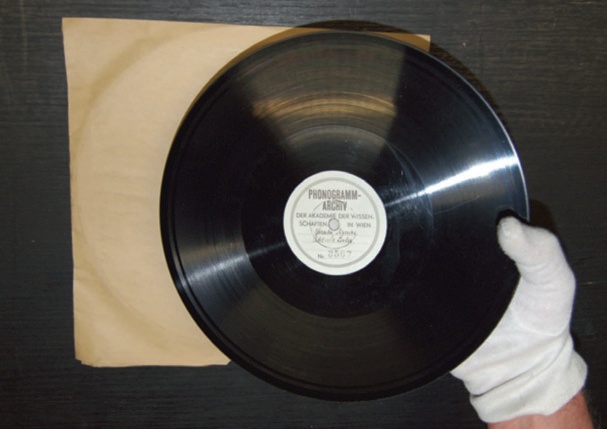
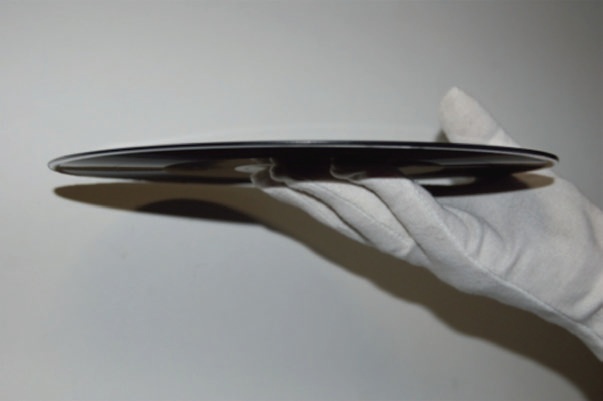
Figures 26 and 27: Holding a disk without touching the grooved area.
Food and drink, especially sweetened soft drinks, are a major threat to all carriers, specifically to magnetic tape cassettes. Eating and drinking is, therefore, absolutely forbidden in all rooms where audiovisual carriers are handled or stored.
With magnetic tape, there are also problems that come from within the tape: dry abrasion (mainly with old CA tapes), exuded lubricants, and smear from hydrolysed tapes constitute major, internally generated obstruction to the replay of deteriorated tapes. Before their replay, such tapes need treatment and cleaning (IASA-TC 04, 5.4.3).
3.5.3. Air pollution, specifically industrial gaseous waste, can affect audiovisual carriers in many ways. There are indicators that suggest that heavy industry gases may have a negative influence on magnetic tape condition.17 It may be assumed, on the other hand, that environments that meet modern standards, which are set in the interest of human health, will not be immediately harmful to audiovisual carriers. Should archives be in the vicinity of industrial areas, however, it may be wise to consider appropriate air filtering. In addition, the exposure of materials to fumes caused by refurbishing work such as painting or gluing must also be critically considered. Appropriate measures have to be taken to avoid any (prolonged) exposure to such vapours. Finally, the residues from tobacco smoke build up on the surface of carriers and equipment, e.g. optical disc player lenses. This is another reason in addition to the risk of fire, to ban smoking, particularly in view of modern high data density formats.
3.5.4 Pests. Tropical areas, in particular, suffer from many forms of insects and pests which are difficult to keep out of laboratories and archives. Generally, most threatened are paper materials associated with audiovisual carriers, such as LP covers and liner notes. There is also a tendency for termites and other small bugs to creep into cassettes. No specific prevention can be given except keeping laboratories and storage areas as sealed as possible. Any chemical prevention should take possible interaction with carriers into consideration. Fumigation, as generally applied in tropical (paper) archives to fight insect affected paper materials, is discouraged because of the unknown possible interaction with carrier components, especially of magnetic tapes.
17. Professional video tapes from the same batch were stored under same temperature/RH conditions in Austrian TV archives in Vienna and Linz. The tapes from Linz, an industrial town with considerable air pollution problems at the time, suffered from significant pigment binder breakdown, the Vienna tapes did not. Although professionally investigated, the phenomenon could not be consistently explained.
3.6 Light, ultraviolet (uv) radiation, x-rays
3.6.1 Light and ultraviolet radiation have several deteriorating effects on audiovisual carriers. Many polymers, e.g. PVC, deteriorate under prolonged or permanent exposure to light. Extremely dangerous is the influence of light to the life of recordable optical discs (“dye discs”). Tests have shown that permanent exposure of such discs to daylight—and specifically direct sunlight—can render them unreadable within weeks.18 To what extent small doses of light over a period of years would influence such discs stored in their containers, but not in dark archival rooms, has not been explored. It is, therefore, wise to avoid any unnecessary exposure of all audio and video carriers to light, and to pay particular attention to ensure that any direct sunlight, which may also cause temperatures above safe limits, is inhibited.
Several audiovisual archives have installed low uv light systems in their storage rooms. This is a wise precaution particularly in busy archives where lights are kept switched on for long periods or permanently.
3.6.2 X-rays, as emitted from airport equipment, has, as opposed to undeveloped films, no influence on audio and video carriers. Tests have shown that extremely high, lethal doses used to decontaminate objects from germs such as anthrax spores, do not harm the recorded signals. It is not known, however, whether and to what extent such treatment may influence the further life expectancy of treated materials.
18. Kunej 2001.
3.7 Stray magnetic fields
Stray magnetic fields are the natural enemy of magnetic recordings. The susceptibility of magnetically recorded signals to deterioration up to erasure depends on the coercivity of the magnetic material—the resistance of a given magnetically orientated material to re-orientation. It also depends on the kind of the signal representation, which have varying sensitivity to partial erasure. The most susceptible signal representation is analogue (linear) audio recording. This also occurs on the (analogue) linear audio tracks of video tapes. FM audio, all video, and all digital signal representations are more resistant to distortion caused by magnetic fields. The permissible magnetic field thresholds are, therefore, given for analogue (linear) audio signal representations.
3.7.1 Magnetic field thresholds
For medium coercivity iron oxide pigments, as typically used for analogue open reel audio recordings (coercivity around 400 Oe (Oersted)) the maximum permissible field strengths have been determined to be:
5 Oe (= 400 A/m) AC
25 Oe (= 2000 A/m) DC
These thresholds have been set at 50% of those levels where influences of magnetic fields on pre-recorded audio tape have become measureable. Chromium and metal tapes have a higher coercivity.
3.7.2 Sources of stray magnetic fields
AC fields are typically produced by ACpowered motors and by transformers. AC power lines do not exhibit significant external fields as long as conductors are close together (which is normally the case). DC fields are radiated by permanent magnets. In contrast to some fears, the magnetic field of the earth is too weak to influence magnetic recordings.
3.7.2.1 Typical threats in audiovisual archives. The most dangerous sources of stray magnetic fields typically used in audiovisual archives are dynamic microphones, dynamic headphones, loudspeakers, and moving coil instruments (level meters). As the field strength falls exponentially with distance, even the strongest fields produced by these gadgets are, at a distance of 15 cm to recorded tapes, well below the above-mentioned DC threshold. Finally, bulk erasers, as used to erase analogue audio and video tapes, have extremely strong magnetic fields and must not be employed in areas where recorded tapes are handled or stored. When separating such devices from handling and storage areas, it must be kept in mind that normal walls do not shield magnetic fields. For risks associated with transport see 4.8.
3.7.2.1.1 De-magnetization of replay equipment (“de-gaussing”). In order to prevent negative influences on recorded tapes, all metal tape guides and heads must be demagnetised at regular intervals (daily, or every 10 hours of use). DC magnetic fields decrease S/N ratio and may increase non-linear distortions. To avoid inadvertent magnetisation, magnetic screwdrivers and other tools must never be used for maintenance of magnetic tape replay equipment. Also, head blocks must only be changed after machines have been switched-off.
3.7.2.2 General threats. Magnetic door shutters of cabinets and magnetic board stickers must be absolutely avoided, as their inadvertent immediate contact with magnetic tape will be harmful. Electromagnetic door holders used for fire divisions should be checked for their field strengths. Electrical motors driving mobile shelves and conveyor belts should be checked, as well as motors of vacuum cleaners used in storage areas. Electric welding must not take place in the presence of magnetic carriers: a distance of one metre minimum should be observed. It is also advisable to check the immediate vicinity around storage areas, as walls do not protect from stray magnetic fields. House transformers or motors of elevators may be immediately adjacent to outside walls and remain unnoticed, especially if they are in neighbouring buildings. For magnetic tape transport see 4.8.3.
3.7.2.3 Metal stacks. In contrast to many fears of the 1950s, metal stacks are normally not dangerous for storing magnetic recordings. Care must be taken to prevent stacks inadvertently becoming part of the lightning conductor system in the event of a strike (3.7.2.4.1). Therefore, the grounding (earthing) of metal stacks, as widely required by general safety regulations, should be critically discussed with specialists. It is very unlikely that magnetic shelves will have a permanent magnetic field. If a shelf does, it probably originates from the use of pick-up magnets during manufacture.19
3.7.2.4 Electromagnetic pulses (EMPs) are single, extremely short, highly energetic broadband bursts of electromagnetic radiation. Although the electromagnetic field of an EMP exists for an extremely short time only, it may be very strong, endangering data carriers in two ways: magnetic carriers may be reoriented and thus have their information erased, while solid state carriers may be destroyed by the high voltages the strong magnetic fields may induce. Apart from data carriers, strong artificial EMPs are a particular concern because of their destructive potential to electronic hardware, electrical installations and, through fire, to entire buildings. Since electromagnetic fields spread with the speed of light, no warning is possible.
There are several forms of natural and artificial, man-made EMPs. In audiovisual preservation, only three forms are of particular interest: lightning, other electrostatic discharges, and EMPs as a result of a nuclear explosion.
3.7.2.4.1 Lightning. Although no damage by lightning conductors in the course of a strike has ever been reported, it is not unlikely this has happened unnoticed in some cases. The magnetic field emitted by a lightning conductor in the event of a strike is dependent on the current the strike generates and the distance from the conductor. Strikes in moderate climatic zones have an average current of around 25–30 kA.20 In tropical areas, however, strikes up to 400 kA have been measured. While for 60 kA a distance of about 5 m is sufficient to diminish the field to the threshold of 25 Oe, the distance needed for a tropical 400 kA strike would be about 33 m. In a properly designed lightning conductor system, however, the strike is diverted to several, separate vertical conductors, each taking a part of the total current. This, in practice, reduces the required safety distance between the lightning conductor and magnetic carriers. All must be done to prevent metal stacks or the plumbing, central heating, etc, to become part of the lightning conducting system in the event of a strike (3.7.2.3). The design of lightning protection should comply with IEC 1024-1.
This potential threat is a generally underrated factor in audiovisual preservation, but should receive careful consideration when reviewing archive safety, or when designing new constructions.
3.7.2.4.2 Other electrostatic discharges (ESD). Insulating material can become electrostatically charged by frictional electricity. For example, human bodies may be charged up to 30 kV after walking over a well-insulated carpet, in particular at very low relative humidity. When touching any conducting objects, a discharge through a little spark happens that creates a very short and high EMP which may result in damaging or even destroying susceptible electronic components—another reason, in addition to dust prevention, to ban carpets from audiovisual archives.
Another effect originates from electrostatically charged discs and magnetic tapes, predominantly those made from PVC. In their replay, electrostatic discharges become audible as clicks both on the output of the machine and acoustically in the room. Such discharges do not damage the carriers, but their annoying influence on the replay must be avoided by discharging carriers before or during replay.
3.7.2.4.3 Artificial EMP. For audiovisual preservation, the most relevant artificial EMP would be the one produced by a nuclear weapon (NEMP). The strength of its magnetic field would depend on various factors (force of detonation, design of the weapon, altitude of explosion), possibly strong enough to erase unshielded magnetic recordings, but also indirectly dangerous by destroying electronic hardware, electric installation and construction through fires caused by high voltages induced in metal conductors.
3.7.2.4.4 Protection against EMP. Although, theoretically, audiovisual archives may be considerably endangered by NEMPs, their probability is, however, extremely low. Protection against EMP for equipment and magnetic carriers can be provided by enclosing them in a Faraday cage and by using appropriate protection circuits (galvanic separation, excess voltage diverters) on all power lines. Buildings and single rooms can be protected by completely covering with earthed, metal wire netting.
Generally, the higher the frequency of the electromagnetic radiation, the smaller the meshes of the wire netting must be. As the spectrum of pulses—theoretically—is indefinite, effective shielding will require a completely sealed, highly conductive metal sheet, e.g. copper, which is well grounded.
3.7.2.5 Print-through is the unintended copying of signals to adjacent layers in the magnetic tape pack. The problem arises because of an uneven spread of coercivity across the particles of a given tape: While high coercivity particles resist re-orientation caused by the magnetic fields of the adjacent layer, a small percentage of low coercivity particles is susceptible to re-orientation. Print-through occurs immediately after recording with the first contact of two layers on the wind-up spool and increases logarithmically with time.21 Apart from the general susceptibility of a given magnetic layer, the level of print-through is also dependent on the thickness of the tape.22 The steepness of the increase in level rises with temperature and is also furthered by the presence of low external magnetic fields.
With the international “oxide in” winding standard, the print is stronger on the outer than on the inner layer of the nourishing signal. When the tapes are stored on the supply reel, the “unnatural” pre-echo is stronger than the less disturbing post-echo. Therefore, “tails-out” storage has gained wide popularity. With German “oxide-out” storage standard (“B-wind”), the opposite applies.
Because print-through is caused by unstable, low coercivity particles, it can be removed to a great extent by winding the tape in the fast-winding mode several times before replay. This makes use of the magnetostrictive effect on low coercivity particles.23
To minimise print-through for further replay, replayed tapes should be brought to storage temperature and then rewound several times to keep the initial print-through level to a minimum.
It must be remembered that any failure to minimise print-through before transfer will make the printed signal part of the new recording.
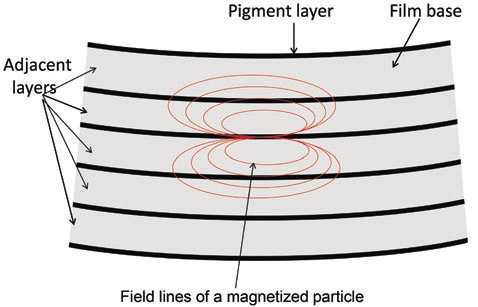
Figure 28: Mutual interference of adjacent magnetic layers.
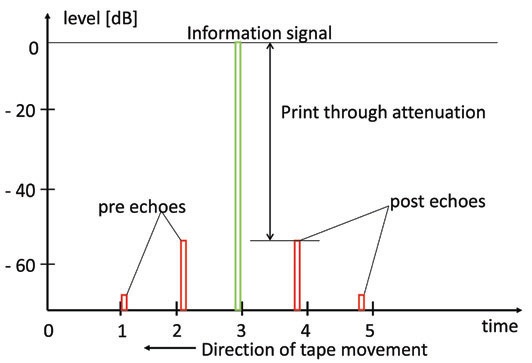
Figure 29: Pre and post echoes.
19. Systematic measurements of metal shelves have shown permanent DC fields in the order of up to 1 Oe. It may be advisable to specify that level as maximal permissible when ordering steel shelves, and measure at delivery.
20. In Austria, for example, average lightning strikes do not exceed 30 kA. Therefore, lightning conductors are specified to withstand a strike of 60 kA.
21. Its increase in the first time unit is the same of that of the next ten and then hundred (or any other exponential series of) time units.
22. Because of its wavelength-to-tape thickness ratio, and because of optimal signal perception in the low-mid frequency range around 1000 Hz, the subjective annoyance also depends on the speed of recording. Thus, print-through is significantly more annoying on a 38 cm/s recording on standard play tape than, e.g. on a compact cassette with its low recording speed of 4.76 cm/s.
23. With most tapes, a print-through built up within 224 days could be reduced below the 24 hour level by fast winding the tape three times (Schüller 1980).
3.8 Cleaning of carriers
3.8 Cleaning of carriers.24 In order to avoid the effects as described under 3.5, carriers must be cleaned to remove all kinds of foreign matter as well as residues and components of chemical deterioration. As a matter of principle, all carriers added to an archive should be cleaned before they enter the storage areas. This is particularly important for dirty/dusty collections from arid climatic zones as well as for carriers or whole collections affected by fungus. Before transfer, carriers must be checked again for dust, dirt, and other foreign matter and appropriately cleaned.
For all carriers (with some exceptions) the following sequence of action should be applied:
Compressed clean air. For infrequent application this is available in pressurised cans. For frequent use, a small compressor with an appropriate filter should be provided.
Gentle mechanical wiping. For mechanical carriers, brushes with bristles softer than the materials to be cleaned, should be available for the careful removal of loose foreign matter. For tapes, soft lint free materials, e.g. pellon® fleece, which can also be mounted in the tape path, should be applied. For cassette tape, cleaning machines are marketed. Great care must be used with optical discs, as cleaning may often result in the production of unrepairable scratches.
Mechanical discs should be cleaned with an action that follows the groove. Optical discs should be cleaned with an action that is radial or across the signal track.
Health considerations must be observed when cleaning fungus from affected carriers and their containers. Such cleaning should be made in a chemical exhaust or fume cabinet or in open air, and operators must wear breathing masks.
Distilled water. Short exposure to water is permissible with most audio and video carriers. The exceptions include some instantaneous discs made from gelatine, cardboard, and similar water-soluble materials. To enhance the action, wetting agents may be added. For application with discs, washing machines are marketed. It is imperative that all carriers be thoroughly dried after the application of water.
Chemical solvents. Their application is the last stage for cleaning residue resistant to the more gentle methods from carriers. They must only be applied after consulting reliable sources and experts. As the composition of carriers, specifically historic tapes and instantaneous discs, is often unknown and their reaction to solvents unpredictable, careful testing must be done. It must be noted that unfavourable reactions may not appear immediately. Specifically the removal of chemical by-products of deteriorating materials must be carefully researched in cooperation with chemical experts. The use of commercial products with undisclosed ingredients is prohibited.
24 .This paragraph deals only with be basic principles of carrier cleaning. For details see the respective sections in IASA-TC 04, chapter 5.
4 Storage Facilities and Transport
4.1 Storage environments
The control of the environment in a storage area is a product of the prevailing conditions in the surrounding area, the construction of the storage facility, the quality of insulation and vapour seal, and the air-conditioning plant; when designing a storage environment all four of these must be taken into account. Overdesigning the air-conditioning plant to compensate for poor insulation, for example, leads to unstable and variable conditions. As has been discussed earlier in this publication, stability is more important than the absolute conditions being met. The following provides some general information that can be used in discussion with the appropriate design specialist.
4.2 Storage area location
Ideally, a storage area should be in the centre of a building, slightly elevated from the ground floor. Such a location would permit effective and autonomous control over all environmental factors, including temperature, humidity and water, dust and pollution, light, as well as stray magnetic fields. Any location at the fringe of a building would make such control more difficult, and possibly less effective. Any location lower than ground level makes air conditioning more expensive, and effective prevention of water influx difficult. Vaults should be fireproof, thermally insulated, and also protected against water influx, which may happen for a number of reasons.
4.3 Air conditioning and environmental control
Air conditioning, environmental control, or building management technology are all terms used to describe systems of varying sophistication that control and manage the environment inside a building. Though such systems were developed principally for the comfort of the occupants of buildings, they are a necessity if the rooms are to meet the long-term storage conditions of the audiovisual collections as specified in this publication. In principle, air conditioning systems are the same whether they are used for preservation and storage or comfort purposes. However, air conditioning systems for collection and storage demand much tighter tolerances and much better control.
4.3.1 Temperature control. Temperature control is achieved through heating or cooling the air that is being blown into the environment to be controlled. Sensors in the room detect the conditions and this information is used to control the heating or cooling elements. The interaction with sensors raises some issues that are discussed below.
It is important to note that cooling is the act of removing heat from an area and transferring it to another environment.
An evaporative cooling system, which passes air through a moist environment and so removes heat energy through evaporation, has no place in an archive, partly because it increases the relative humidity. In any case, it is only effective in very dry environments.
A critical fact in the design of environmental control systems is that heating air reduces the relative humidity and cooling air increases the relative humidity. Stable temperature and stable humidity are both of importance and their control is linked: for this reason all temperature control must be coupled with humidity control (3.2.3).
4.3.2 Principles of dehumidification. Almost all storage environments will require dehumidification most of the time in order to remove moisture from the air and so comply with the conditions specified in this publication. The need for humidification, the addition of moisture to the air, is much more rare and, if needed, can be achieved fairly simply. Relative Humidity, which is the most common way to specify moisture in the air, is a percentage measure proportional to the amount of moisture the air could hold at a given temperature and pressure, the latter being dependent on altitude.
Dehumidification is the removal of moisture from the air to reduce the relative humidity. As was stated above, cooling air increases the relative humidity. If the temperature of the air is made lower it will eventually reach a point at which the moisture in the air condenses to form droplets of liquid. The temperature at which the moisture condenses is known as the “dew point”.
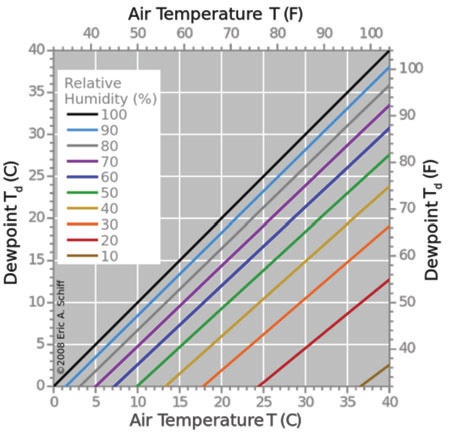
Figure 30: Table of dew point levels. (By Easchiff (own work) [CC-BY-SA-3.0-2.5-2.0-1.0 (http:// creativecommons.org/licenses/by-sa/3.0)], via Wikimedia Commons)
The most common way to dehumidify an environment is to cool the air being treated to a temperature well below the dew point and, thus, remove moisture from the air as water droplets. The treated air is then heated to the required temperature and the resultant relative humidity is a product of the amount of moisture removed by cooling and the final temperature of the air being treated.
This approach though practical, simple and common, has a number of significant problems. Firstly, the energy cost in cooling and then reheating air is quite substantial and should be considered as a factor in the long term running of any environment. Secondly, the amount of moisture removed from the air is proportional to the temperature differential and a system will often have to be overdesigned in order to be suitable for a wide range of environmental conditions experienced in many places. This is a particular problem in cool environments. And finally, it is very difficult to get accurate control using these sorts of systems, which may lead to cycling such that the system constantly seeks to adjust the conditions and this leads to regular increases and decreases in temperature and humidity, which is in itself detrimental to the storage of collection material.
Desiccant dehumidification is the removal of moisture from the air within a storage area by using a substance (desiccant) that is able to absorb moisture. The desiccant is subsequently heated, outside the controlled area to remove the absorbed moisture after which it can be reused. Such systems can achieve the low levels of dehumidification required for archival storage in most environments and are more energy efficient than the common cooling and heating approach described above.
4.3.3 Sensors are the devices used to detect temperature humidity and other aspects of air quality and condition. Most sensors used in an office environment have tolerances of ±5% or greater. While this is adequate when controlling office environments, when used in critical systems such as archival storage they cannot achieve the tolerances specified in this document.
Sensors detect the conditions in the controlled environment and communicate that information to the air conditioning system. In its simplest form, when conditions are outside of those required, the system switches on; when they are within required conditions the system is turned off. When the system operates in this manner the conditions in the controlled environment can cycle between high and low which has an adverse effect on the materials being stored. In order to overcome this, modern systems with high quality sensors and control technology gradually switch in and out heating and cooling elements leading to a very stable storage environment.
It is common practice to place sensors in the flow of air being extracted from the storage area. However, a poorly designed system can result in pockets or spaces within the storage environment that may be out of specification but undetected by the system (microclimates). Multiple sensors are recommended, with an appropriate agreement on how the sensors are weighted in determining the room conditions.
4.3.4 Air quality and filtering. Air conditioning systems are generally designed to recycle the air in an environment by adding a pre-set proportion of fresh air from outside. The smaller the proportion of fresh air, the simpler and more cost-effective it is to maintain the required conditions. The amount of fresh air is a health issue and most countries have standards that specify a minimum figure of around 10% fresh air. Though storage environment could have a lower proportion of fresh air this would necessitate sensors to determine the build-up of carbon dioxide and other unwanted gases in the storage rooms. It is also likely that the plastics in the media being stored will give off gases, which would build up in such an environment. Therefore, figures near 10% are a suitable compromise between cost and clean air. The flow of air through the room must reach every part in order to prevent any localised build-up of contaminants.
Pumping treated area air into an environment will almost certainly lead to a build-up of dust and other airborne particulates. Air conditioning systems must have filters that remove those particulates. The type of filter and the size of the particulates it removes will depend on the quality of the air both inside and, particularly, outside the building. In addition to well-maintained filters, the amount of dust in an environment can be minimised by maintaining a higher pressure in the room compared to the surrounding area.
For storage areas and laboratories, clean room classes ISO 8, preferably ISO 7 according to ISO 14644-1 should be the target.25
The presence of sulphur dioxide, nitrogen dioxide and oxides of nitrogen, and other gaseous pollutants will degrade the life expectancy of the carriers stored in an environment. Most countries have a specification for air quality, and will recommend particular filter classes.
All filters require regular maintenance and cleaning in order for them to be effective.
25. ISO 8 equals clean room class 100.000 according to former US FED STD 209E, ISO 7 class 10.000.
4.4 Walls, materials, heat transfer, and permeability to moisture
The most effective way of controlling environmental conditions is to build a room with good thermal insulation and constructed with materials that are reasonably impermeable to the transfer of airborne moisture. Standard building materials such as stud plaster walls, bricks, and cinder blocks do not provide very effective insulation against temperature change and allow high levels of moisture to pass into the storage environment. If these materials are used, sealants must be applied to all surfaces, and all gaps, including around doors, must be sealed. The use of airlocks at doorways should also be considered.
One good way to provide a temperature controlled storage environment is to build an insulated envelope or structure within an existing building (4.2). The walls of such an envelope can be made from highly impermeable materials such as rigid aluminium and polystyrene sandwich panels as used to build food storage areas. All entry spaces including doors, electrical and other ducts, screw holes and fixing components must be sealed, as effective vapour sealing of the rooms is vital to their performance. Most places that use this type of building technology report being able to significantly reduce the size and cost of air conditioning plant. In the event of a disastrous loss of power, such storage environments maintain their conditions for a longer period of time.
4.5 How to specify required conditions for a contractor
It is often difficult to specify clearly to a builder or air-conditioning specialist the requirements for a storage environment. Merely stating the target temperature parameters may not produce a successful outcome. It is suggested that the following parameters be considered.
- Set point for temperature and humidity
- Tolerances expressed in values above and below the set point
- Frequency of change (the period of cycle between high and low)
- Rate of change (the gradient of the cycle)
- Amount of fresh air expressed in percentage of cycled air
- Air cleanliness expressed in terms of percentage, or the quality of filter necessary to remove that content
- Air flow throughout the room
- Number of sensors and their placement, and the means of determining the overall conditions
- Energy consumption under a range of conditions
An alternative to the standard supply contract is a performance contract in which the performance is defined in terms of given standards or approaches, but the supplier is commissioned over a given period of time to maintain and manage the system so that it continues to meet those standards. This is likely to be more expensive, but provides a strong incentive for the supplier to meet the specified conditions in the long term.
4.6 Shelving
4.6.1 Material. Today, metal (steel) shelves are generally used. There is no risk in using them for storage of magnetic carriers (3.7.2.3). Wooden stacks, preferred in the 1950s and 1960s, are now discouraged as chemical treatment components may interact with audiovisual carriers.
4.6.2 Shelf loads. Shelves must be sufficiently sturdy to carry the load of audiovisual carriers. The approximate weight of 1 metre of carriers including typical containers is:
| Audio | |
|---|---|
| Replicated 78 rpm (“shellac”) records 25 cm (10”) | 72 kg |
| Replicated 78 rpm (“shellac”) records 30 cm (12”) | 92 kg |
| Vinyl discs 17 cm ( 7”, singles) | 21 kg |
| Vinyl discs 25 cm (10”) | 38 kg |
| Vinyl discs 30 cm (12”) | 54 kg |
| Magnetic tape 13 cm (5”) reels | 12 kg |
| Magnetic tape 18 cm (7”) reels | 18 kg |
| Magnetic tape 27 cm (10.5”) reels/hubs | 48/40 kg |
| Magnetic tape 30 cm (12”) on hubs | 50 kg |
| CDs in boxes (jewel case) | 7 kg |
| Video | |
| Magnetic tape 2” : 30/45/70/90 min | 84/114/120/142 kg |
| Magnetic tape 1” : 75/126 min | 75/87 kg |
| U-matic | 22 kg |
| Half inch format cassettes, average | 8 kg |
| DVDs in boxes | 6 kg |
4.6.3 Storage position. All carriers, discs, tapes, and any cassettes should be stored upright. For discs, shelf separators should be in a distance of half of the discs diameter. Discs should not be tightly packed, however narrow enough to avoid permanent inclined position. Divisions for tapes are usually the same size of their diameter. During the absence of carriers in use, dummy replacements must be used to maintain upright position until carriers are returned.
Only soft, instantaneous discs, like gelatin or Decelith discs, should be stored horizontally in small piles with not more than 10 in a stack.
4.7 Containers
Ideally, carriers should be kept in chemically inert containers designed to provide sufficient protection against mechanical damage through normal handling and protection against light. With the advancement of conservation research over the past decades, the autocatalytic actions of several polymer degradation processes have been understood. Consequently, the use of airtight storage is not recommended as it could trap endogenous degradation by-products, thus increasing the rate of degradation. Generally, dust prevention should be achieved by proper insulation and air filtering of the entire storage environment. This will allow air to flow around the carriers which will help retard, if not prevent, autocatalytic deterioration. Where effective dust prevention of the entire storage area is not possible, a decision for carrier related dust prevention will depend on the relative risks of threats from internal changes in the carrier versus unavoidable external threats.26
The materials preferred for containers designed to replace damaged or inadequate original ones are polypropylene and polybutylene for magnetic tape boxes, polyethylene bags or acid free paper sleeves for vinyl discs, and acid free paper sleeves for shellac records. For cylinder storage, the Association for Recorded Sound Collections (ARSC), in collaboration with the Library of Congress, has developed an Archival Cylinder Box27.
Original containers or wrapping materials often suffer from a variety of problems: an acidic cardboard may have been used for tape boxes and disc sleeves; acidic paper for liner notes and booklets for LPs and CDs, as well as for inlays for notes for all kind of blank audio and video cassettes. In the early days of LPs, PVC sleeves were sometimes used which may cause plasticiser migration to damage LP surfaces.
Having optimisation of life expectancy in mind, ideally all carriers should be separated from inadequate original containers, wrapping and other accompanying materials. All such action should, however, be carefully considered and the improvements in storage conditions balanced against the financial and great organisational challenges such a task may demand. The great majority of containers and accompanying materials are themselves carriers of information that form a constituent part of the total document. Any loss or disorder through inappropriate cross referencing of separated parts of the document will generally cause much greater damage to the integrity and usefulness of the material than any theoretical optimisation of life expectancy. Generally, therefore, it is recommended that such exchanges be restricted to cases of obvious and immediate threat, such as PVC or other inadequate sleeves for LPs, or the removal of plastic bags from CA tapes.
26. Archives in moderate climatic zones may thus arrive at different solutions than those in hot and arid environments.
27. This container is designed for storing a single “standard-size” cylinder phonograph record. For details, contact Bill Klinger (Chair of the ARSC Cylinder Subcommittee) at klinger@modex.com.
4.8 Transport
Transport requires adequate measures against shock, climatic changes, and stray magnetic fields.
4.8.1 Shock prevention. The most shock sensitive carriers are cylinders and shellac records. These require adequate shock absorbing packaging, particularly when carriers are shipped by post or freight. Cylinder packing requires a careful balance between the prevention of any movement inside their boxes, movement of boxes inside outer containers, and appropriate measures for shock absorption. Additionally, attention must be paid to the prevention of elevated temperatures, specifically through unnoticed sun radiation. Because of their importance, transport of cylinders is often entrusted to art transport specialists (4.8.4). Shellac records require a box-in-box packaging. Inner and outer boxes shall be made from strong cardboard, separated in all directions by a layer of styrofoam or similar shock absorbing materials. It is imperative that discs inside the inner box are absolutely tightly packed to prevent any movement against each other. Vinyl discs are less shock sensitive, but an equal level of protection is wise to prevent damage to their covers. The same measures, particularly tight packing, are imperative for magnetic tape on open hubs to prevent any movement within the wind of the tape or movement of the tape pack on the hub or even slipping off the hub.
4.8.2 Heat and humidity. Any transport will expose carriers to climatic conditions outside optimal storage parameters. As a first measure, a method and routing of transport, including seasonal considerations, should be chosen to minimise these risks by avoiding exposure to extreme climatic conditions. Additionally, adequate packing must prevent unavoidable temperature changes and exposure to humidity. A typical threat is moisture penetration of carriers after long periods in cold environments and subsequent exposure to warmer and more humid conditions. Examples include transport in cargo holds of airplanes and landing in hot and humid climatic zones. Countermeasures include the provision of sufficient thermal insulation in the packing material during transport and, after transport, the carriers should be aired to prevent trapping high moisture levels and the temperature allowed to slowly return to normal. Whenever possible, audiovisual carriers should be transported in the cabin of air planes. Transport in unpressurised cargo holds should be avoided whenever possible.
4.8.3 Stray magnetic fields. The magnetic fields produced by metal detectors at airports for checking hand luggage are normally too weak to influence the recorded signals of audio or video tapes. As detectors for luggage to be carried in the hold may produce stronger magnetic fields, it is generally recommended that recorded magnetic tapes be transported as hand luggage. There is no information, however, on possibly dangerous stray magnetic fields with other transport systems, such as electrical railways, subways and buses, or other electrically driven transport machines. Such risks may be very low, as no incidents have been reported that would point to such sources of danger. However, in order to eliminate this risk, it may be advisable to protect magnetic carriers of exceptional value by carrying them in metal boxes of highly permeable materials.
A greater threat, however, may be the increasingly common electrically powered cars. Before concrete measurements of their stray magnetic fields are available, great caution is advised. It is important that tapes should be carried in metal boxes, or the use of such vehicles avoided until more is known about the possible dangers.
4.8.4 Cooperation with specialised transporters. The transport of large quantities of carriers, e.g. the relocation of whole collections, should be jointly planned and arranged with specialists in the field of transport of art treasures.
5 Disaster Preparedness: Fire, Water, and Uninterrupted Power Supply
5.1 General
Disaster preparedness includes all measures to prevent, or at least minimize, the negative effects of unpreventable incidents of all kind, be they of natural origin, such as earthquakes and extreme weather conditions (which seem to be becoming more common in recent years), or man-made, like civil unrest, warfare, and others. The basic elements of disaster preparedness start with factors such as the choice of site for new archive buildings. A systematic search for any intrinsic dangers in existing archive buildings and their neighbourhoods should also be undertaken. Detailed plans to react appropriately in the case of unpreventable disasters will need to be prepared. These should have the protection of staff and visitors, as well as the survival of the collection, as the foremost principles to be considered.
A detailed discussion of disaster preparedness is beyond the scope of this publication. Environmental influences and specific preventive measures have been discussed in the respective parts of chapter 3. However, because of particular risks of fire and water to audiovisual carriers, these two aspects are covered here.28 Finally, because of the absolute dependence on electric power, the necessity of an uninterrupted power supply in the case of disaster is underlined.
28. For general aspects of disaster preparedness, see bibliography.
5.2 Fire
Fire prevention and extinguishing must be given utmost importance. Beyond the safeguarding of invaluable material it must be understood that burning audiovisual carriers produce highly toxic fumes, which are of considerable risk to health. In addition to irreplaceable losses of holdings, complicated and expensive decontamination of premises may be the result of such incidents.
Ideally, the entire building housing an audiovisual collection should be separated into smaller fire divisions or zones of appropriate dimensions and equipped with a fire detection system. The walls, floor, and ceiling of each storage area should be fireproof and equipped with an automated fire extinguishing plant. In the 1970s and 1980s, Halon gas29 was widely used as a fire-extinguishing agent for sensitive cultural materials. This was also recommended by IASA in 1981 (IASA-TC 02). Because of its effect on the depletion of the ozone layer, Halon and other fluorochlorinated hydrocarbon agents were banned in the Protocol of Montreal in 1989. Today, a number of more environmentally friendly Halon replacement gases are available for traditional materials as well as for server rooms of digital archives. These are also recommended for audiovisual materials.
The so called “dry fog” systems, that spray water in a very finely dispersed mist into the vault, are gaining popularity as the cooling effect is of great help with the protection of carriers exposed to heat from a fire, while water damage is very minimal. Such systems can be used for all kinds of archives. They are unsuitable, however, for electrical installations such as digital repositories (servers). Some archives are also starting to use low-oxygen storage, a technology that reduces the oxygen level in the air in the storage area below the point where a fire can be sustained.
Hand-held fire extinguishers should contain CO2. Water, foam, and powder, the most popular agent used in office-type extinguishers, must not be used. While chemically harmless, the removal of the fine dust of powder extinguishers from contaminated audiovisual carriers is extremely time consuming and is sometimes not possible to achieve.
29. Halon and its replacement gases extinguish fires in a concentration that is not dangerous for persons inadvertently trapped in a storage area in the case of flooding. Carbon dioxide (CO2) would be very effective and cheaper, but its use is strongly discouraged, often forbidden by legislation, because of the enormous risk for personnel, particularly in the case of false alarms.
5.3 Water
Apart from keeping humidity low (3.1), special attention must be given to the prevention of water influx, which may come from a variety of sources. Storage areas should, therefore, be protected against water influx from all sides. This is most easily achieved if the store is located in an elevated position above the ground floor. A waterproof ceiling will prevent influx of water caused by plumbing leakages, heavy rainfall and water from fire extinguishing in upper floors. There should be no connection to the sewerage system, which, in case of floods, would be a path for influx. If an underground location cannot be avoided, careful consideration must be given to the prevention of influxes resulting from inundations, particularly in tropical areas, where storms can produce unexpectedly high amounts of water in a very short time. The installation of automated pumps may be advisable. In any case, materials should be stored some distance above the floor to help safeguard them for a period in the case of influx and give time for preventive actions to become effective. (For drying and cleaning flooded materials see 3.1.2.)
5.4 Uninterrupted power supply
The operation of audiovisual archives depends on the availability of electric power. An uninterrupted power supply is essential for maintaining a digital repository and is also an essential for the operation of fire alarms and extinguishing systems. Even in technically highly developed areas, an uninterrupted power supply must always be a part of the respective systems. Additionally, to cope with the individual situations faced by developing countries, independent power supply units that produce sufficient power to keep the archive in operation in the case of frequent or prolonged black outs must be installed.
It should be kept in mind, however, that even in areas with normally reliable public power supplies, fire or unusual natural disasters will probably lead to power supply problems for which preventive measures must be in place. Most important is the provision of battery powered emergency light installations that will permit the safe evacuation of visitors and staff and assist the organisation during rescue measures. Additionally, depending on the necessity to keep equipment in operation, such as automated pumps to keep water out of storage rooms, adequately powerful stand-by generators with auto-starting mechanisms must be in place. These standby systems must be tested periodically.
6 Conclusion
Even if all the advice and recommendations given herein are carefully observed, there is a statistical risk of losses that cannot be excluded. This means that even in an archive of the highest professional standard, the loss of any given carrier is possible. The only measure to minimise risks is to keep at least two copies of each archival item.
“One Copy is No Copy”
is the guiding principle of audiovisual archives, and this principle is an imperative for both analogue and digital carriers.
Select Bibliography
1. General, principles
- BOSTON, G. (Ed): Safeguarding the Documentary Heritage. A guide to Standards, Recommended Practices and Reference Literature Related to the Preservation of Documents of all Kinds. UNESCO, Paris 1998. http://www.unesco.org/webworld/mdm/administ/en/guide/guidetoc.htm extended CD-ROM version UNESCO, Paris 2000
- IASA Task Force on Selection, Marcella Breen et al (Ed): Selection criteria of analogue and digital audio contents for transfer to data formats for preservation purposes. International Association of Sound and Audiovisual Archives (IASA) 2004. http://www.iasa-web.org/task-force
- IASA Technical Committee: The Safeguarding of the Audio Heritage: Ethics, Principles and Preservation Strategy, edited by Dietrich Schüller (=IASA Technical Committee - Standards, Recommended Practices and Strategies, IASA-TC 03), Version 3, 2005. http://www.iasa-web.org/tc03/ethics-principles-preservation-strategy also available in French, German, Swedish, Spanish, Italian, Russian, and Chinese.
- IASA Technical Committee: Guidelines on the Production and Preservation of Digital Audio Objects, edited by Kevin Bradley (=IASA Technical Committee - Standards, Recommended Practices and Strategies, IASA-TC 04), 2004. Second edition 2009. http://www.iasa-web.org/tc04/audio-preservation
- WARD, A.: A manual of sound archive administration. Gower Publishing, England, 1990.
2. Audiovisual Archiving Conference Proceedings
- Proceedings of the Joint Technical Symposia (JTS)
- Joint Technical Symposia have been organised 1987 – 2000 by the Technical Coordination Committee (TCC) of the Audiovisual Archives Associations IASA, FIAF and FIAT; from 2004 onward by the Coordinating Council of the Audiovisual Archives Associations (CCAAA). Topics of articles cover all subsections of this bibliography.
- TS 1987 Berlin - Orbanz, E. (Ed): Archiving the Audio-visual Heritage. Proceedings of the (Second) Joint Technical Symposium, Berlin 1987. Berlin 1988.
- JTS 1990 Ottawa - Boston, G. (Ed): Archiving the Audio-visual Heritage. Proceedings of the Third Joint Technical Symposium, Ottawa 1990. Milton Keynes 1992.
- JTS 1995 London - Boston, G. (Ed): Archiving the Audio-visual Heritage. Proceedings of the Fourth Joint Technical Symposium, London 1995. Milton Keynes 1999.
- JTS 2000 Paris - Aubert, M. and R. Billieud (Eds): Image and Sound Archiving and Access: The Challenges of the 3rd Millennium. Proceedings of the (Fifth) Joint Technical Symposium, Paris, 2000. Paris 2000.
- JTS 2004 Toronto - (website closed).
- JTS 2007 Toronto - http://www.jts2010.org/jts2007/proceedings.html (programme only, contents unavailable). 30 All URLs in this bibliography were accessed in June 2014.
- JTS 2010 Oslo - http://www.jts2010.org
- Proceedings of the AES 20th International Conference Archiving, Restoration, and New Methods of Archiving, Budapest, 5-7 October 2001, AES New York 2001.
3. Carriers, their composition, physical and chemical stability
This section contains inter alia “classical” literature: basic general articles and papers that had introduced and discussed the dominating preservation concerns of their time. It should be noted that materials used for the manufacture of audio and video carriers and their specific composition vary widely, as do production procedures, which influence stability of carriers. Results of these papers refer to the specific carriers under examination and, within these limits, results and conclusions may be valid. Generalising extrapolations, however, could be misleading, and should therefore be seen critically. See also 2.2.1.1.2 -2.2.1.1.3.
- ADDIS. M. and G.VERES: Knowledge data base and report on [U-Matic ] tape condition. PrestoSpace Deliverable D 6.2, 2007. http://www.prestospace.org/project/deliverables/D6.2.pdf
- BERTRAM, N. and A. ESHEL: Recording Media Archival Attributes (Magnetic), New York 1980.
- BRADLEY, K.: Restoration of Tapes with a Polyester Urethane Binder. In: Phonographic Bulletin 61/1992. http://www.iasa-web.org/restoration-tapes-polyester-urethane-binder
- BREMS, K.: The Archival Quality of Film Bases. In JTS 1987, Berlin.
- BURT, L S.: Chemical Technology in the Edison Recording Industry. In: Journal of the Audio Engineering Society 10-11/1977.
- EDGE, M.: Approaches to the Conservation of Film and Sound Materials. In JTS 2000, Paris.
- FONTAINE, J.-M.: Eléments de caractérisation de la qualité initiale et du vieillissement des disques CD-R. In JTS 2000, Paris.
- GILMOUR, I. and V.FUMIC: Recent Developments in Decomposition and Preservation of Magnetic Tape, in: Phonographic Bulletin 61/1992. http://www.iasa-web.org/magnetic-tape-decomposition
- HAYAMA, F. et al: Study of Corrosion Stability on DAT Metal Tape. Paper read at the 92nd AES Convention, Vienna, March 1992. AES Preprint 3237.
- ISOM, W.R.: Evolution of the Disc Talking Machine. In: Journal of the Audio Engineering Society 10-11/1977.
- KHANNA, S.K.: Vinyl Compound for the Phonographic Industry. In: Journal of the Audio Engineering Society 10-11/1977.
- KUNEJ, D.: Instability and Vulnerability of CD-R Carriers to Sunlight. In: Proceedings of the AES 20th International Conference Archiving, Restoration, and New Methods of Archiving, Budapest, 5-7 October 2001, AES New York 2001, 18-25.
- MÜLLER, R.: On Improvements of Magnetic Tape. Shown by Measurements on Early and Newer Tapes. In: Journal of the Audio Engineering Society 10/1988.
- NAUMANN, K.E. and E.D. DANIEL: Audio Cassette Chromium Dioxide Tape. In: Journal of the Audio Engineering Society 10/1971.
- Oesterreichische Akademie der Wissenschaften: Method for Reconditioning Data Carriers. Inventors: P. Liepert, L. Spoljaric-Lukacic, N. Wallaszkovits. Appl. filed 23.12.2011, published 05.07.2012. IPC: G11B 23/50 (2006.01), G03D 15/00 (2006.01). Pub. No.: WO/2012/088553.
- PINHEIRO, E., W.-D. WEBER and L. A. BARROSO: Failure Trends in a Large Disk Drive Population. In: Proceedings of the 5th USENIX Conference on File and Storage Technologies (FAST’07), February 2007. http://static.googleusercontent.com/media/research.google.com/de/archive/ disk_failures.pdf
- RUDA, J.C.: Record Manufacturing: Making the Sound for Everyone. In. Journal of the Audio Engineering Society 10-11/1977.
- SCHROEDER, B., and C.A. GIBSON: Disk Failure in the real World: What does an MTTF of 1,000.000 Hours mean to you?”. Proceedings of the 5th USENIX Conference on File Storage and Technologies, 2007. http://static.usenix.org/events/fast07/tech/schroeder/schroeder.pdf
- SCHÜLLER, D.: Archival Tape Test. In: Phonographic Bulletin 27/1980.
- SCHÜLLER, D.: Magnetic Tape Stability. Talking to Experts of Former Tape Manufacturers. In IASA Journal 42, 2014.
- SMITH, L.E.: Factors Governing the Long Term Stability of Polyester-Based Recording Media. National Institute of Standards and Technology (NIST), Washington 1989.
- SONY: Archived Stability of Metal Video Tapes, MPG Technical Report, vol. 6.
- THIÉBAUT, B., L.B.VILMONT and B. LAVÉDRINE: Report on video and audio tape deterioration mechanisms and considerations about implementation of a collection condition assessment method. PrestoSpace Deliverable D6.1, 2006. http://www.prestospace.org/project/deliverables/D6-1.pdf
- WALLSZKOVITS, N., P. LIEPERT, L. SPOLJARIC, and L. LUKACIC: Some not so well considered facts about ageing of plastics in audiovisual media. http://www.forum-kunststoffgeschichte.de/ Forthcoming 2014.
4. Handling, environmental factors, storage conditions
- AES-Standards31, available from http://www.aes.org/publications/standards/list.cfm
- AES-11id (2006): AES Information document for Preservation of audio recordings - Extended term storage environment for multiple media archives (= ISO 18934 2011).
- AES22-1997 (2003): AES recommended practice for audio preservation and restoration -- Storage and handling -- Storage of polyester-base magnetic tape (= ISO 18923 2000).
- AES49-2005 (r2010): AES standard for audio preservation and restoration - Magnetic tape - Care and handling practices for extended usage (=ISO 18933 2012).
- ASCHINGER, E.: Report on Measurements of Magnetic Stray Fields in Sound Archives. In: Phonographic Bulletin 27/1980.
- British Standards Institution: Guide for the storage and exhibition of archival materials, 2012. PD 5454:2012.
- BYERS, F. R.: Care and Handling of CDs and DVDs - A guide for Librarians and Archivists. NIST Special Publication 500-252. National Institute of Standards and Technology, Washington DC, 2003. http://www.itl.nist.gov/div895/carefordisc/
- CALAS, M.-F. et J.-M.FONTAINE (Eds): La conservation des documents sonores. Paris 1996.
- COPELAND, P.: Manual of analogue audio restoration techniques. The British Library. London 2008. http://www.bl.uk/help/manual-of-analogue-audio-restoration-techniques
- DIN 45 519, Teil 1: Magnetbänder für Schallaufzeichnung, Bestimmung der Kopierdämpfung, Februar 1976.
- FIAF (Ed): Preservation and Restoration of Moving Images and Sound, Brussels 1986.
- FONTAINE, J.-M.: Conservation des Enregistrements Sonores sur Bandes Magnétiques: Etude Bibliographique. In: Analyse et Conservation des Documents Graphiques et Sonores: Travaux du Centre des Recherches sur la Conservation des Documents Graphiques 1982-1983. Paris 1984.
- GELLER, S.B.: Erasing Myths about Magnetic Media. In: Datamation, March 1976.
- ISO 18923 2000 Imaging materials – Polyester-base magnetic tape – storage practices.
- ISO 18933:2012 Imaging materials -- Magnetic tape -- Care and handling practices for extended usage.
- ISO 18934:2011 Imaging materials -- Multiple media archives -- Storage environment.
- ISO 18938:2008 Imaging materials -- Optical discs -- Care and handling for extended storage.
- ISO 18925:2013 Imaging materials -- Optical disc media -- Storage practices.
- KNIGHT, G.A.: Factors Relating to Long Term Storage of Magnetic Tape. In: Phonographic Bulletin 18/1977.
- Library of Congress: Cylinder, Disc, and Tape Care in a Nutshell. http://www.loc.gov/preservation/care/record.html
- McWILLIAMS, J.: The Preservation and Restoration of Sound Recordings, Nashville, 1979.
- PICKETT, A.G. and M.M. LEMCOE: Preservation and Storage of Sound Recordings, Washington 1959. Reprint by ARSC, 1991.
- SCHÜLLER, D.: Preservation of Audio and Video Materials in Tropical Countries. In IASA Journal 7/1996, 35-45. Revised edition in: International Preservation News 54, 31-43. http://www.ifla.org/files/pac/ipn/IPN54def.pdf
- St-LAURENT, G.: The care and handling of recorded sound materials.1996. http://palimpsest.stanford.edu/byauth/st-laurent/care.html
- WELZ, G.: On the Problem of Storing Videotapes. In JTS 1987.
5. Storage, building, air conditioning, general safety, disaster preparedness
- American Society of Heating, Refrigerating and Air-Conditioning Engineers (ASHRAE) (Ed): ASHRAE Handbook. Four volumes. http://www.techstreet.com/ashrae/ashrae_handbook.html
- HÄFNER, A.: Disaster Preparedness, Response and Recovery. In IASA Journal 42/2014.
- IEC: Protection of structures against lighting IEC 1024-1.
- ISO 10456:2007 - Building materials and products -- Hygrothermal properties -- Tabulated design values and procedures for determining declared and design thermal values.
- ISO 14644-1:1999 - Cleanrooms and associated controlled environments -- Part 1: Classification of air cleanliness.
- LOTICHIUS, D.: Sicherheit zuerst - auch für Tonträger. In Phonographic Bulletin 4/1972.
- LOTICHIUS, D.: Measures for the Preservation and for the Protection of Archived Program Property on Sound Carriers. In: Phonographic Bulletin 31/1981.
- MATTHEWS, G. and J. FEATHER (Ed): Disaster management for libraries and archives. Ashgate 2003. http://www.bl.uk/services/npo/journal/0504/disaster.html
- SEIBERT, A.: Guidelines for a comprehensive emergency preparedness plan including risk assessment, communication system, training and supplies. Library of Congress, Washington DC. http://www.loc.gov/preserv/pub/seibert
31. AES and respective ISO Standards are content-wise identical, apart from minor editorial differences.
List of TC members
List of TC members (in alphabetical order)
- George Boston
- Kevin Bradley, National Library of Australia
- Mike Casey, Indiana University, Bloomington, USA
- Stefano S. Cavaglieri, Fonoteca Nazionale Svizzera
- Matthew Davies, National Film and Sound Archive, Australia
- Carl Fleischhauer, Library of Congress, USA
- Jean-Marc Fontaine, Laboratoire d’Acoustique Musicale, France
- Jouni Frilander, Finish Broadcasting Corporation
- Lars Gaustad, National Library of Norway
- Ian Gilmour, National Film and Sound Archive, Australia
- Bruce Gordon, Harvard University, USA
- Albrecht Häfner
- Clifford Harkness, Ulster Folk and Transport Museum, UK
- Jörg Houpert, Cube-Tec International, Germany
- Jean Christophe Kummer, NOA Audio Solutions, Austria
- Drago Kunej, Slovenian Academy of Sciences and Arts
- Chris Lacinak, AVPreserve, USA
- Franz Lechleitner, Phonogrammarchiv Austrian Academy of Sciences
- Hermann Lewetz, Östereichische Mediathek, Austria
- Xavier Loyant, Bibliothèque nationale de France
- Guy Marechal
- Michel Merten, Memnon Archiving Services, Belgium
- Stig-Lennard Molneryd, National Library of Sweden
- Greg Moss, National Film and Sound Archive, Australia
- Yvonne Ng, WITNESS, USA
- Marie O’Connell, New Zealand Film Archive
- Bronwyn Officer, National Library of New Zealand
- Will Prentice, British Library
- Richard Ranft, British Library
- Dietrich Schüller
- Tommy Sjöberg, Folkmusikens Hus, Sweden
- Gilles St-Laurent, Library and Archives Canada
- Adolph Thal
- Nadja Wallaszkovits, Phonogrammarchiv Austrian Academy of Sciences
- Eduardo Sánchez Zamorano, Fundación Harp, Mexico